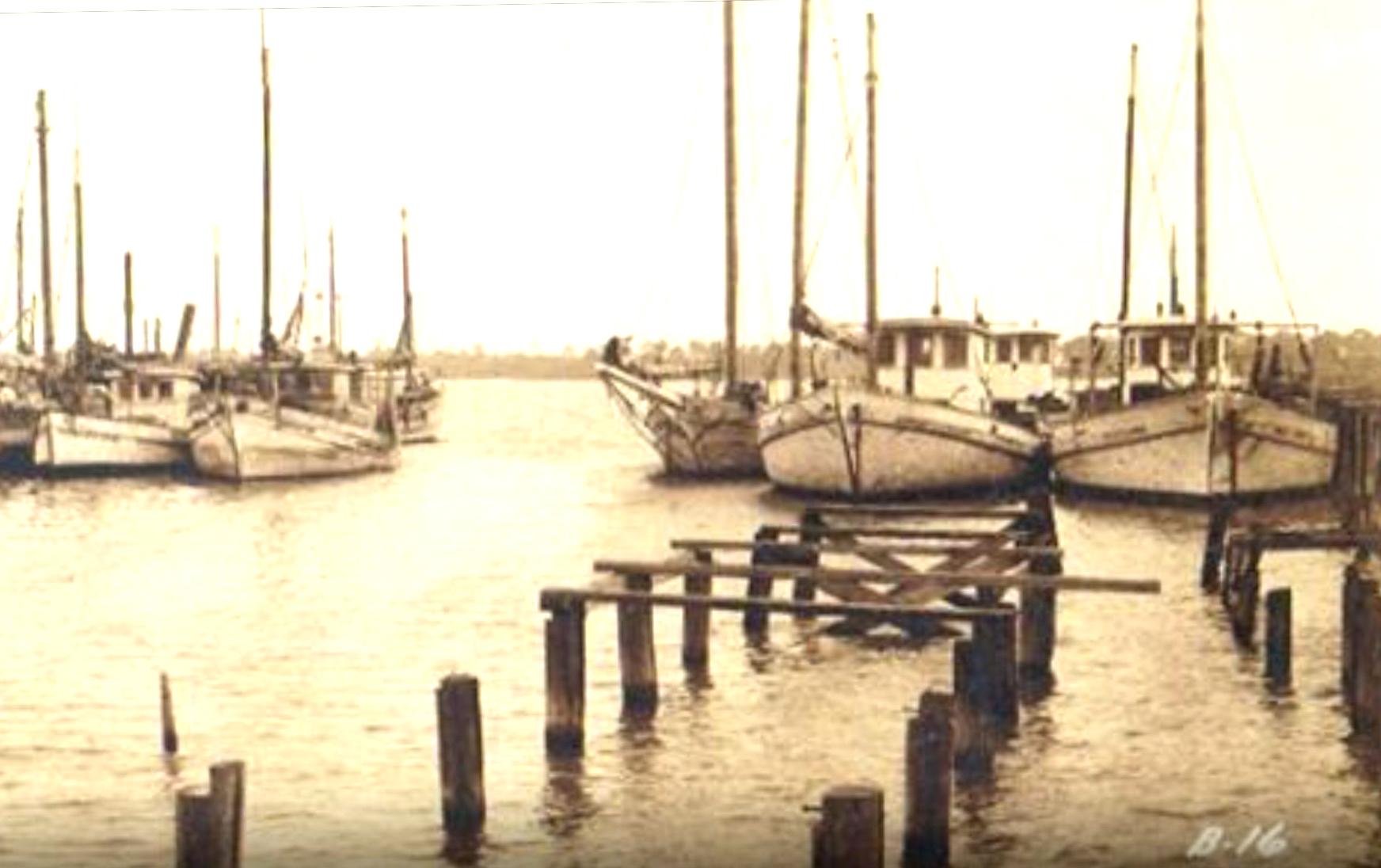
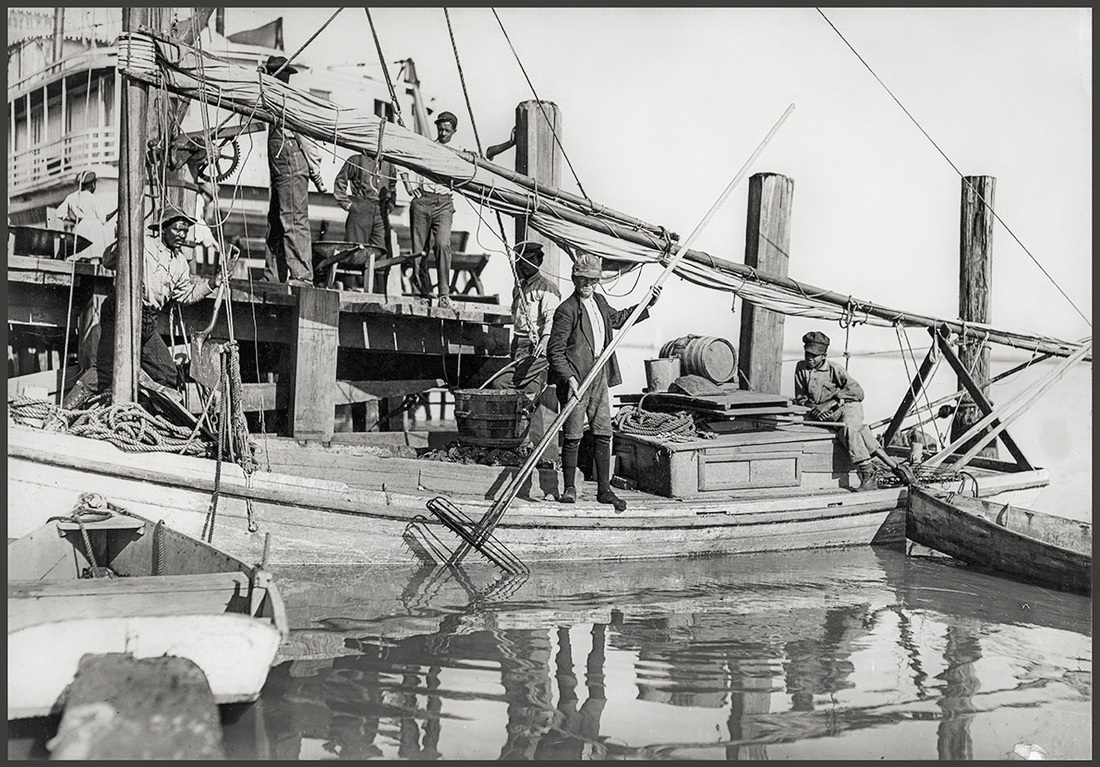
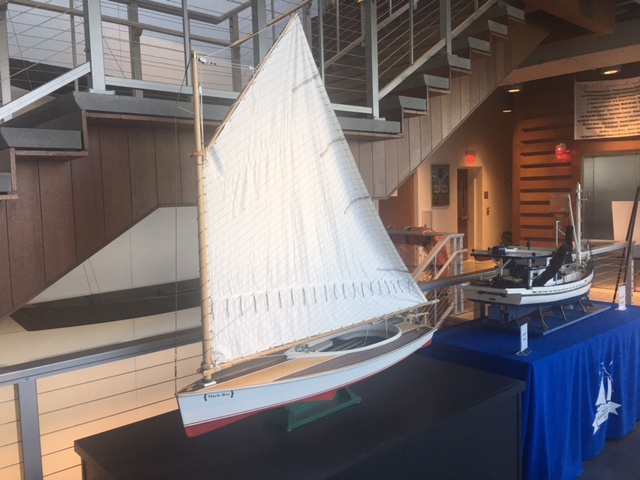
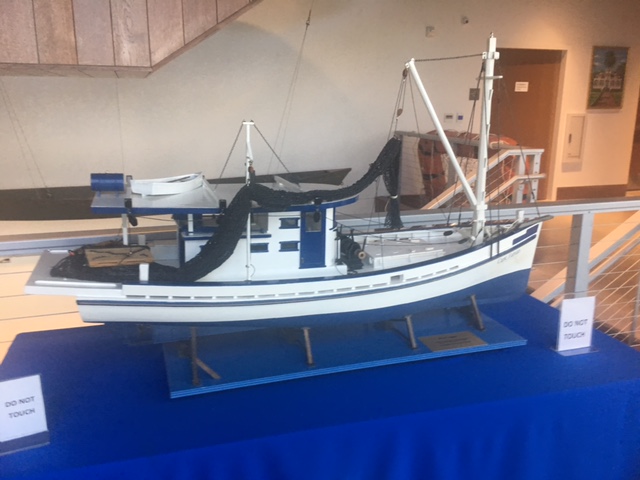
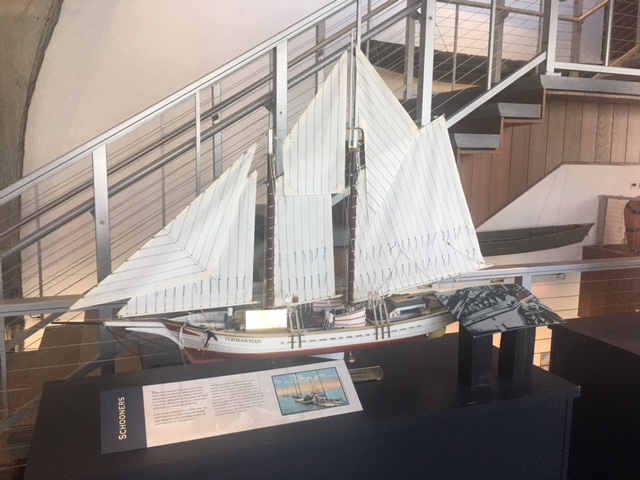
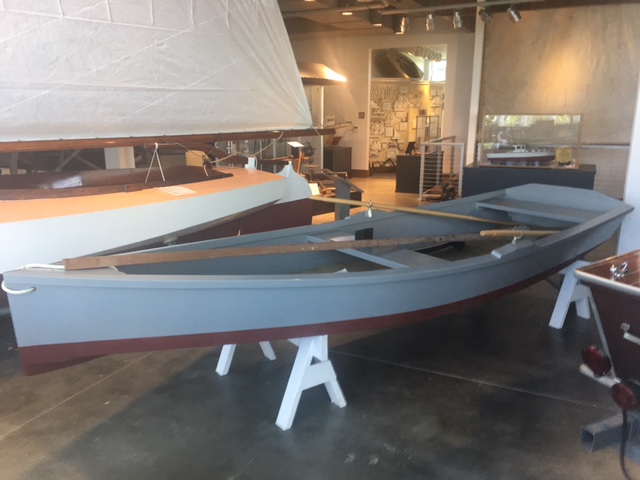
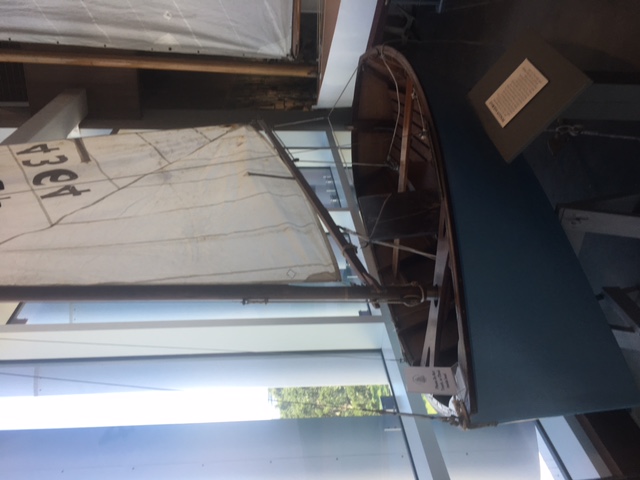
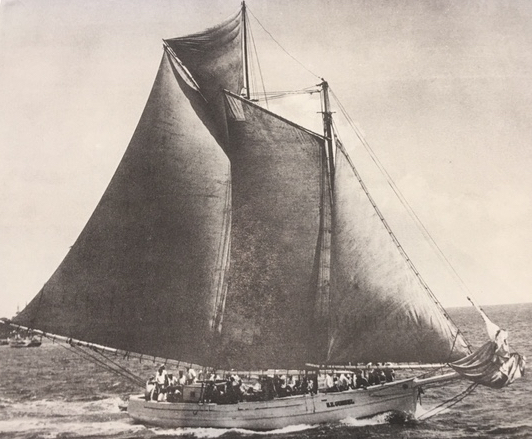
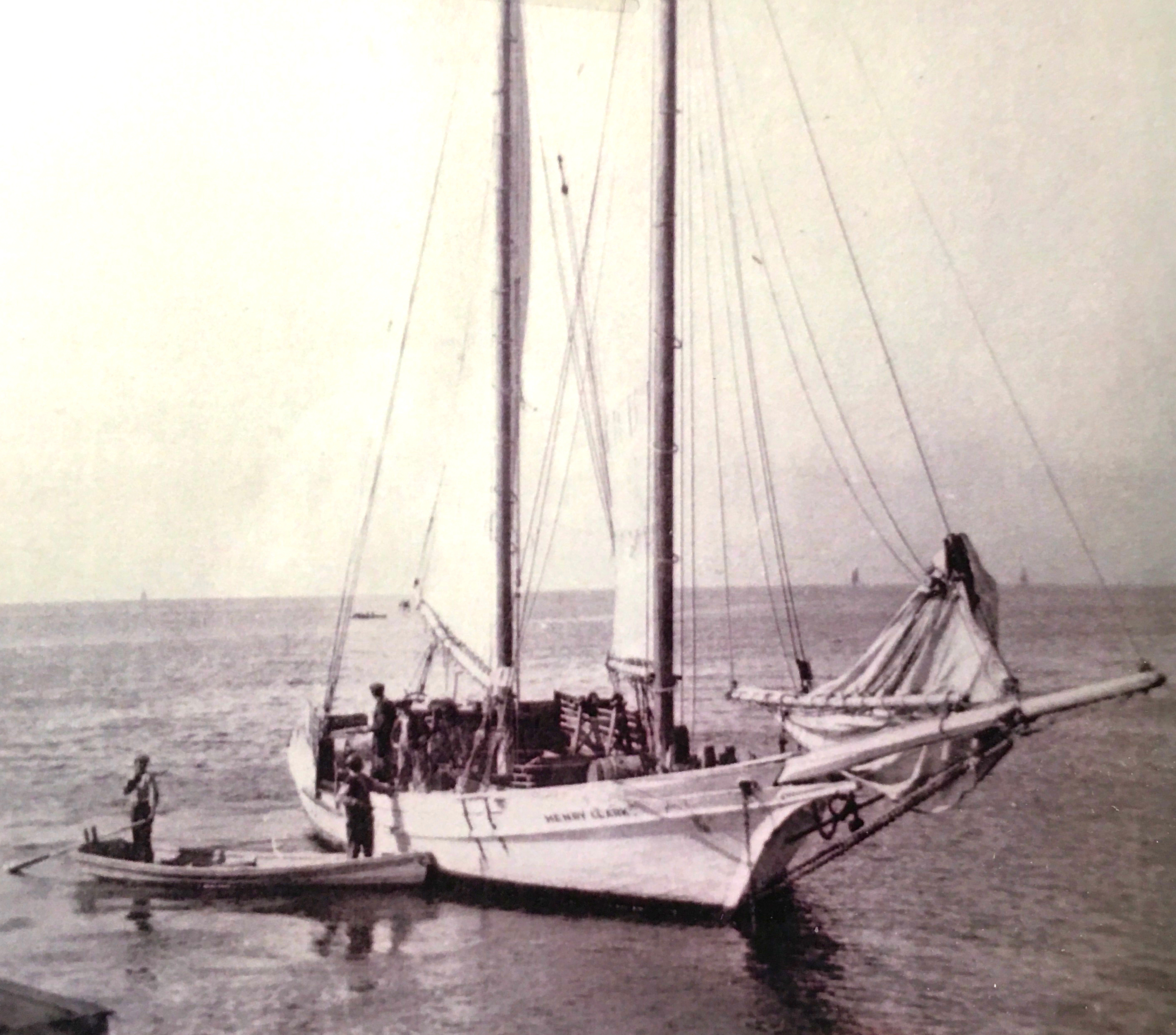
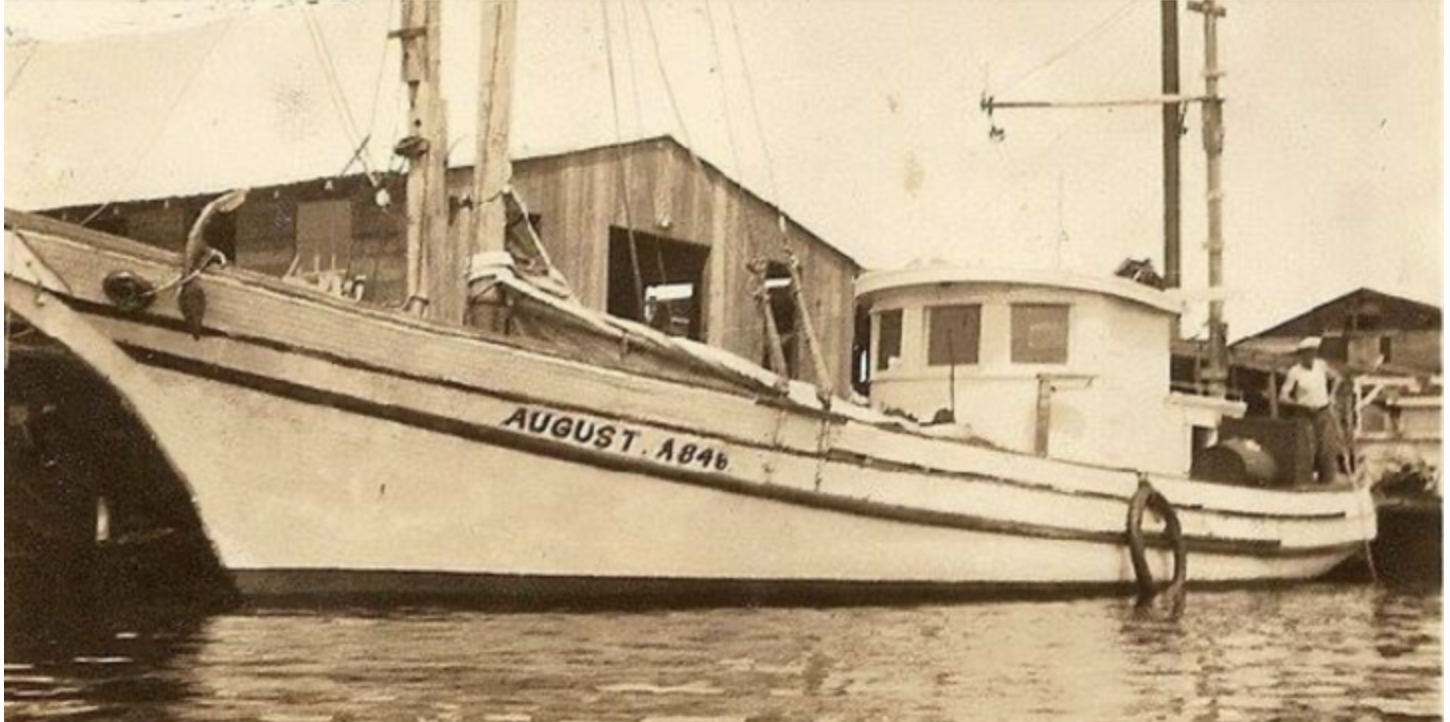

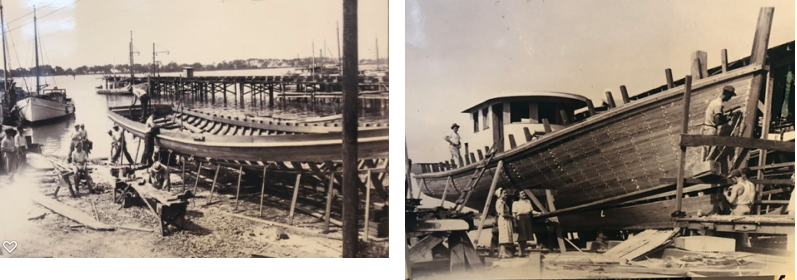
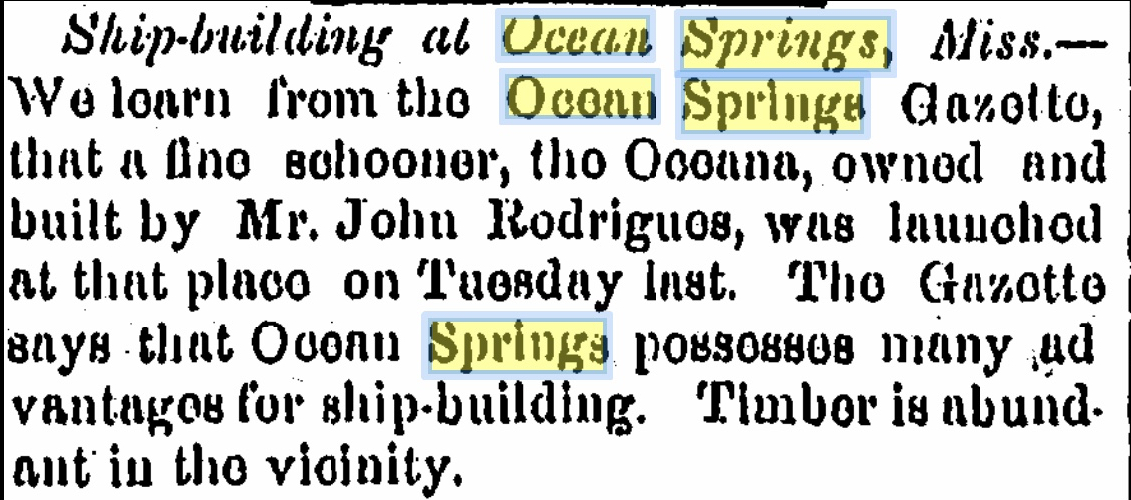
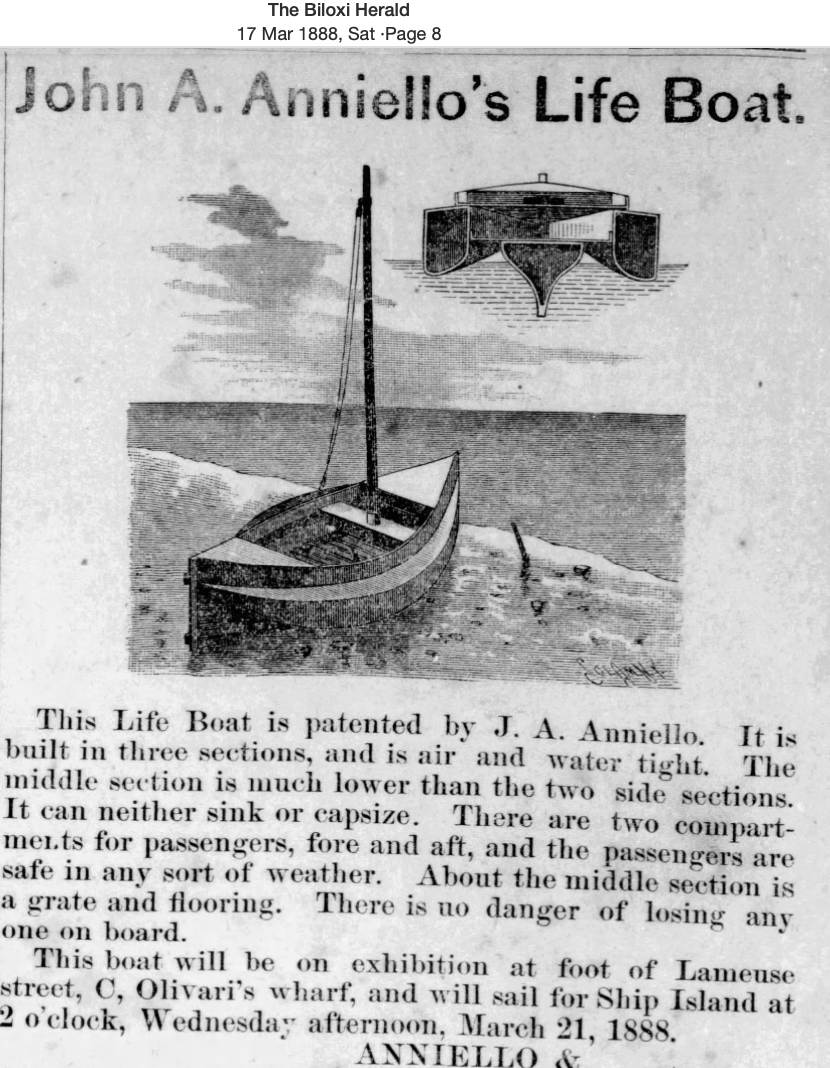
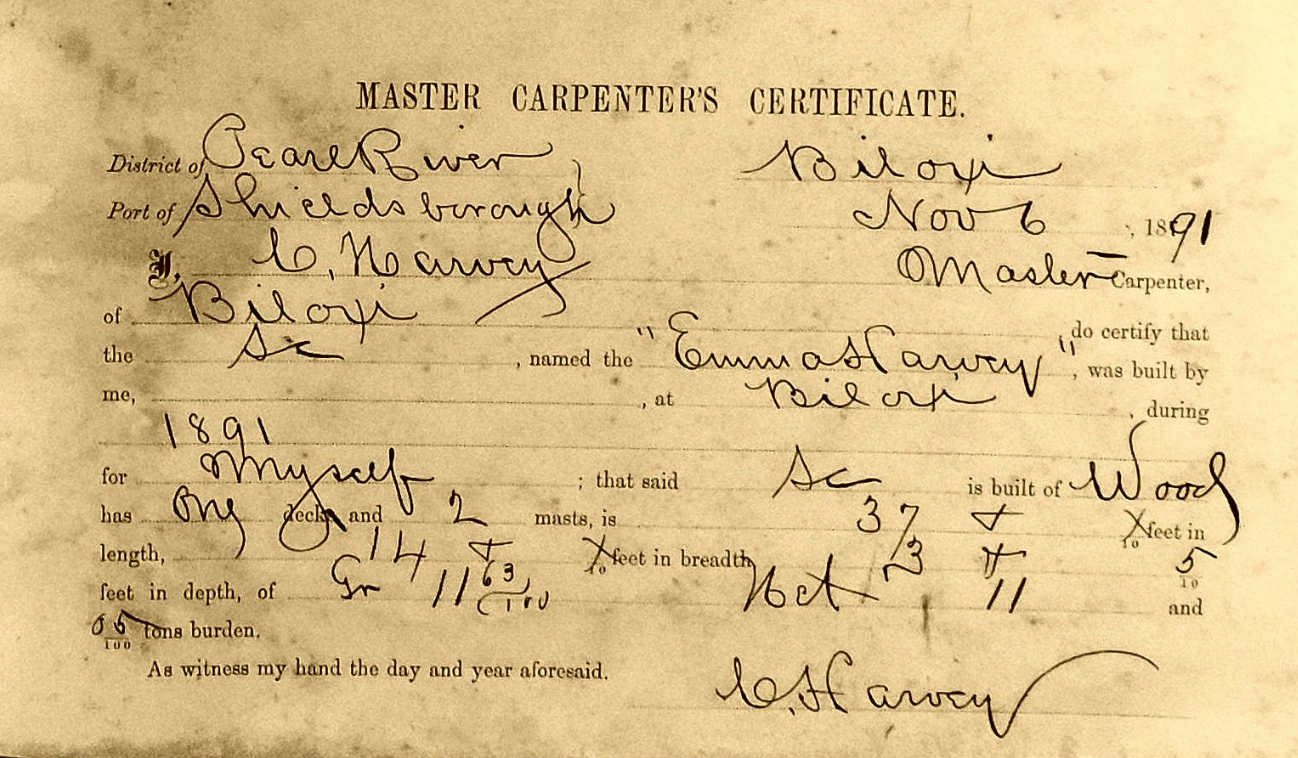
In early May, a sloop is launched and rigged at W.N. Johnson’s Shipyard in Biloxi and sailed to Southern Yacht Club as Joanne.(The Biloxi Herald, May 2, 1896, p. 8 and The Daily Picayune May 11, 1896)
Nydia, a 30-foot, cabin sloop with a 9-foot beam and built by William Nels Johnson (1861-1914) of Biloxi, Mississippi was at the Southern Yacht Club in New Orleans and owned by John A. Rawlins (1867-1944). The vessel was built with oak frames and planked with 7/8 inch, choice cypress.(The Biloxi Herald, May 8, 1897, p. 5)
The Rowena, a stern wheel steamer, built for Lopez, Dunbar Sons' and Company and costing about $5000, was under construction by Frank Taltavull. The vessel was to be utilized as a steam dredge with the capacity for 150 barrels of oysters.[The Biloxi Herald, July 31, 1897, p. 8]
1899
1900
Two Frank Taltavull (1851-1930) built vessels, the schooner, A. Gerdes and Brother, and the steam tug, Julius Elbert, became involved on May 29, 1901. Captain Antoine V. Bellande (1829-1918) was in command of the schooner in the Mississippi Sound en route to Ocean Springs. The seven-man crew was below preparing for bed with a green sailor at the helm. The weather roughened and his inexperienced allowed the vessel to capsize. Captain Bellande and his crew were found by the Julius Elbert clinging to their stricken ship. They were rescued and having lost all their possession to the sea.(The Biloxi Daily Herald, May 29, 1901)
The Taltavull shipyard on Back Bay launched a large schooner for Lopez & Dukate on October 1st. Yet to be named, the vessel was 62 feet in length with an 18-foot beam. This was the second schooner built for them this year by Taltavull.(The Biloxi Daily Herald, October 1, 1901, p. 8)
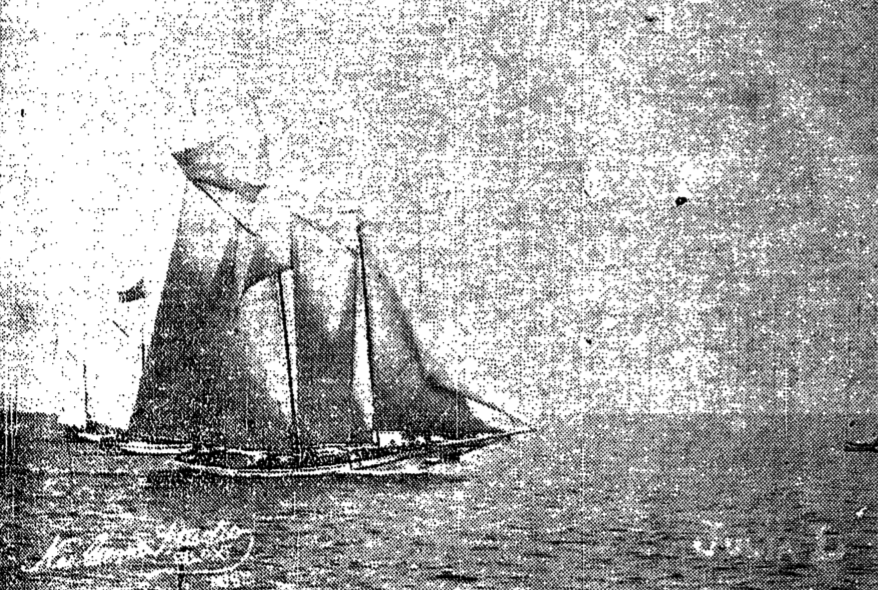
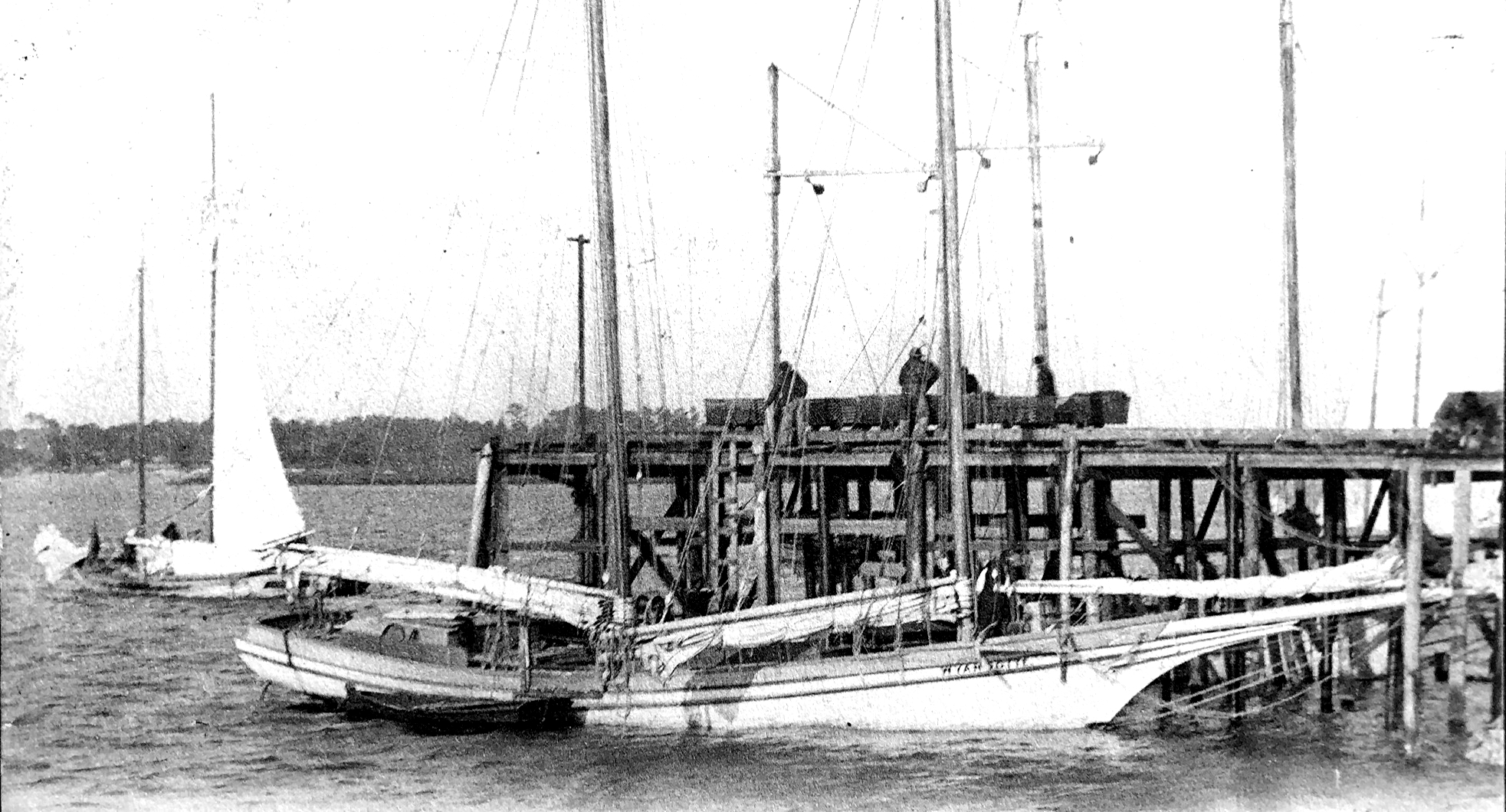
Wyandotte
[probably moored at the W.F. Gorenflo factory on Back Bay at Main Street]
Another Casimer Harvey [1845-1904] built schooner depicted in this vintage postcard was the Wyandotte. The Wyandotte was constructed in 1903-1904 for William F. Gorenflo [1844-1932], pioneer Biloxi seafood magnate and philanthropist. The Gorenflo factory was situated on Back Bay near Main Street. The vessel was measured by Vincent J. Tucei, Deputy Collector of Customs, in late January 1904. Like the Emma Harvey, the Wyandotte, was a victim of the 1916 July Storm. She was capsized and beat to pieces in Back Bay while owned by O.D. Gunn.[The Biloxi Daily Herald, January 27, 1904, p. 6 and The Daily Herald, July 7, 1916, p. 7]
The Indian Girl was launched in July at Lazarus [North Biloxi] by the Trochesset Brothers.(The Biloxi Daily Herald, July 19, 1904, p. 5)
The Tulip built by Mack Flechas for E.C. Joullian was measured at Biloxi in October.(The Biloxi Daily Herald, October 10, 1904, p.5)
Southern Yacht Club Commodore, John A. Rawlins, sold Nydia to A. Baldwin Wood (1879-1956) in December.(The Daily Picayune, December 14, 1904, p. 12)
1905
In September 1911, John Jelusich (1871-1945) was captain of the Apache and was working in the Louisiana marsh near White Grass Island for the Gorenflo factory when his crew discovered the corpse of a young man tied to a stake. They believed the body was placed there to be retrieved by Parish officials.(The Daily Herald, September 6, 1911, p. 8)
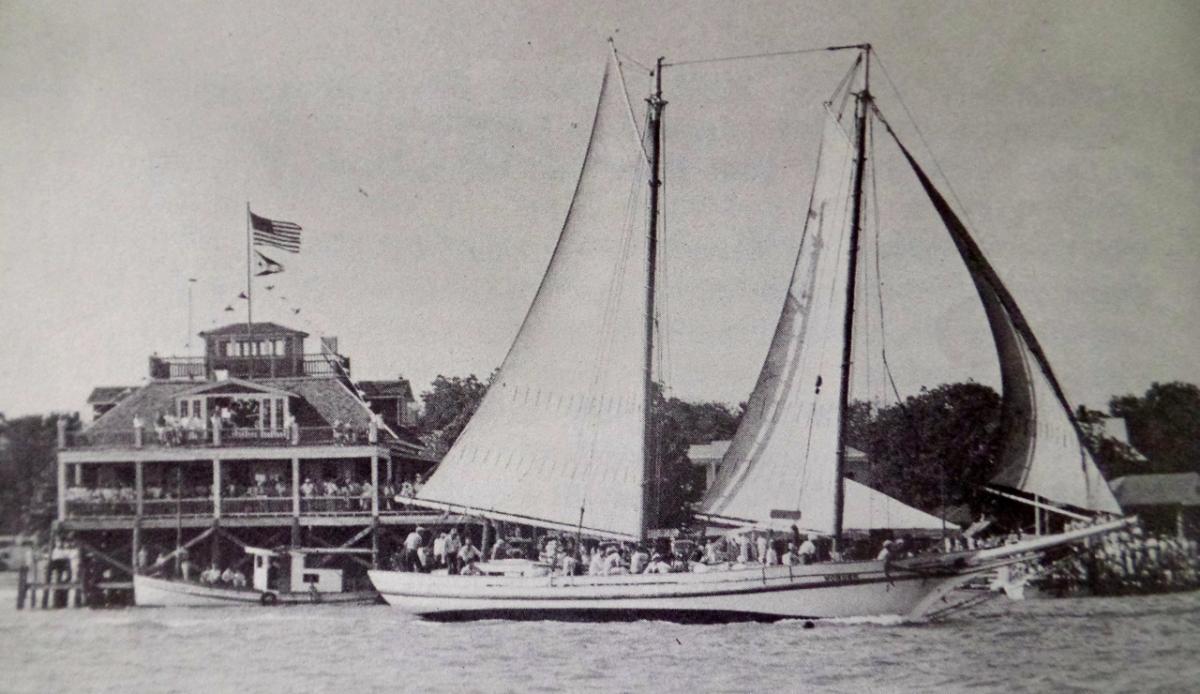
On July 2nd, Augustus ‘Gussie’ Fountain (1883-1926) registered his newly built Clara Fountain, a fishing schooner, with Lewis E. Curtis, U.S. Deputy Collector of Customs. The large vessel was named for Gussie’s spouse, Clara Noble (1887-1939). The Clara Fountain was 53.7 feet long; 18 feet at the beam; and 14 feet deep. It went to work for the Foster-Fountain Packing Company who already had the schooners, Mercedes Baltar and Leroy in their fishing fleet.(The Daily Herald, July 3, 1915, p.8)
In August, Fred Moran completed a 30-foot, motor launch for Dunbars, Lopez and Dukate to be used to tow vessels at their Brunswick, Georgia factory.(The Daily Herald, August 4, 1915, p. 2)
The American Girl sank with a load of oysters near Half Moon Island, St. Bernard Parish, Louisiana in mid-December. Captain Peter Parker was fishing for the Desporte Brothers. He was accompained by Captain James Parker, master of the New Resident when the incident occurred. The Eccentric, a gasoline boat, was sent to salvage the oyster catch, but she also sank. The American Girl was raised and working again in short time.(The Daily Herald, December 18, 1915, p. 1, Decemebr 23, 1915, p. 2 and December 30, 1915, p. 2)
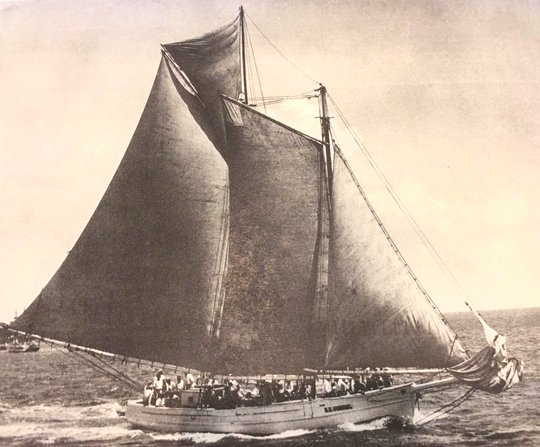
On the eve of July 5, 1925, the Isle of Caprice resort opened for business. Fun seeking tourists departed for the resort from landings at the Biloxi Yacht Club, White House, Riviera Pavilion, and Wachenfeld’s Pier. The Silver Moon, commanded by Ed L. Moran (1888-1951), the brother of A.P. ‘Fred’ Moran (1897-1967) of Ocean Springs, Jolly Jack, Charles Redding, and Margaret provided transportation. In the new pavilion, music was made by the Buena Vista Orchestra.(The Daily Herald, July 6, 1925, p. 3)
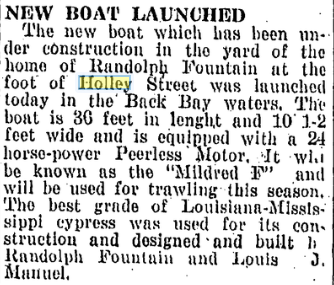
In June, Captain Peter Skrmetti, master of the Pan American, a converted Biloxi schooner, made excursion trips to the Isle of Caprice and the other barrier islands. The vessel had a length of 66 feet with a 22-foot beam and a seating capacity of 200 and a maximum passenger capacity of 300. There was also a small dancing platform on the boat. It made two trips daily from Desporte’s Pier for the Isle of Caprice.(The Biloxi News, May 30, 1926, p. 1 and June 6, 1926, p. 20)
Captain Ernest L. Moran (1888-1951), son of Francis D. Moran and Elizabeth L. Vanderpool, and brother of A.P. Moran (1897-1967) of Ocean Springs, commanded the Iona Louise, a Biloxi charter boat. In September 1926, he announced that his vessel would discontinue daily trip to Ship Island. Instead, it would make the voyage to the Isle of Caprice departing at 1:45 P.M. from the Buena Vista and Biloxi Yacht Club piers. The Iona Louise left the islet at 6:00 P.M.(The Daily Herald, September 1, 1926, p. 2)
Additional marine transportation service to the Isle of Caprice was provided by the Silver Moon operated by Captain Ed Moran (1881-1951) and the Water Witch of Captain Foster Swetman (1893-1953).(The Biloxi News, May 30, 1926, p. 1)
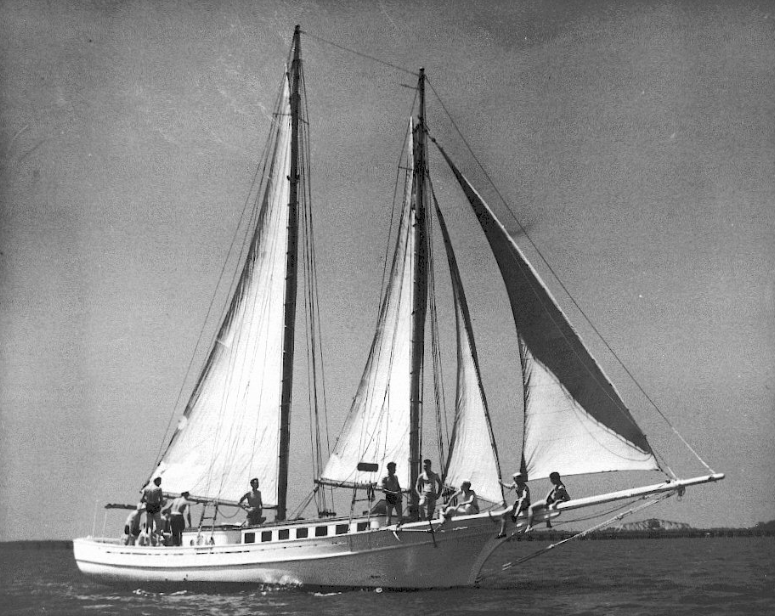
1927
When placed into service in May 1927, the Nonpareil was the largest pleasure craft ever used in the barrier island service of the Mississippi Gulf Coast. The vessel had been acquired from the US government and had served as a pilot boat. The Nonpareil was 100 feet in length with a 19-foot beam and had the capacity to carry about 250 passengers to the Isle of Caprice or for fishing charters. Power generated from two Wolverine, 4-cycle, full diesel 70s of the Ellis type costing $12,000 drove the vessel at about 15 mph. The Nonpareil was captained by M.B. Spottswood and Peter Harvey while Captain Lee Bosarge located fish for the clientele. The craft was refurbished at the Frentz Brothers Shipyard on Back Bay for the Isle of Caprice Amusement Company led by promoters, Walter H. Hunt and Arbeau Caillavet.(The Daily Herald, May 6, 1927, pp. 1-2)
1928
Jules Galle completed the Eunice C., a 44-foot, oil screw, for William Cruso. It was powered by a 24 HP Lathrop engine.(The Daily Herald, August 17, 1929, p. 1)
A.I. Fountain finished the Thelma B., a 44 foot x 15 foot x 4 foot oiler powered by a 24 HP Lathrop engine at North Biloxi for N. Byrd.(The Daily Herald, August 17, 1929, p. 1)
Peter Skrmetti was delivered On Time from a Pascagoula shipyard.(The Daily Herald, August 17, 1929, p. 1)
Mike Halat (1879-1929) drowned in Lake Borgne when fell off the Arcadia run by Captain Steve Rodolfich. Halat's body was found near the Rigolets by Captain Vincent Kuluz of the Annie Long.(The Daily Herald, August 31, 1929, p.1)
On August 12, 1934, J.J. “Ben” O’Keefe (1894-1954) christened the ‘Big Ben O’Keefe’, a 40-foot fishing vessel, built for the Cruso Canning Company of William Cruso. The boat was built by Adolph Toche (1900-1988) at the Parker Shipyard on Back Bay and was the seventeenth of the Cruso fleet. Big Ben O’Keefe had a 17-foot beam and could haul 175 barrels of oysters. Captain Pete Wescovich chose to honor Mr. O’Keefe.(The Daily Herald, August 13, 1934, p. 8)
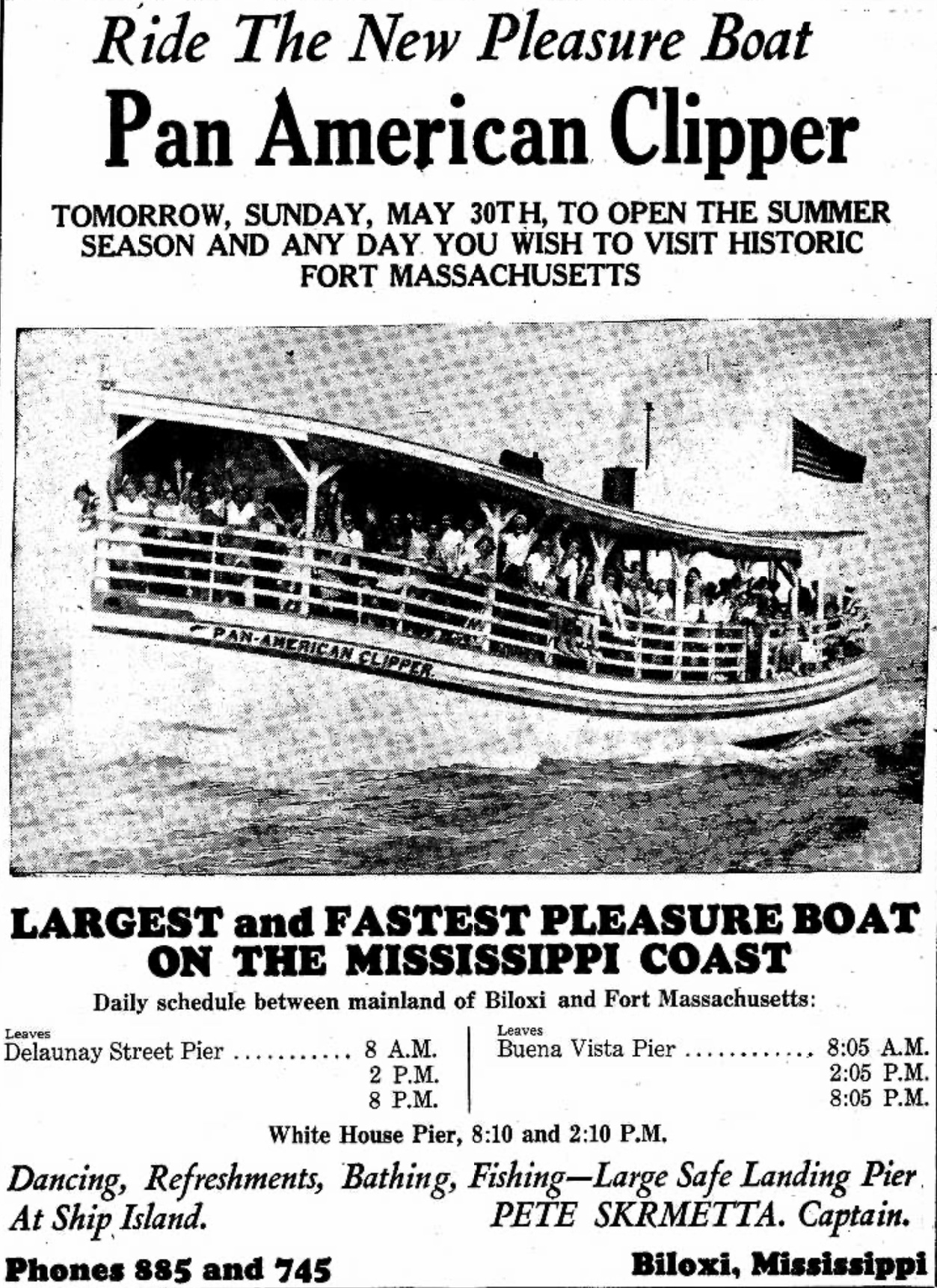
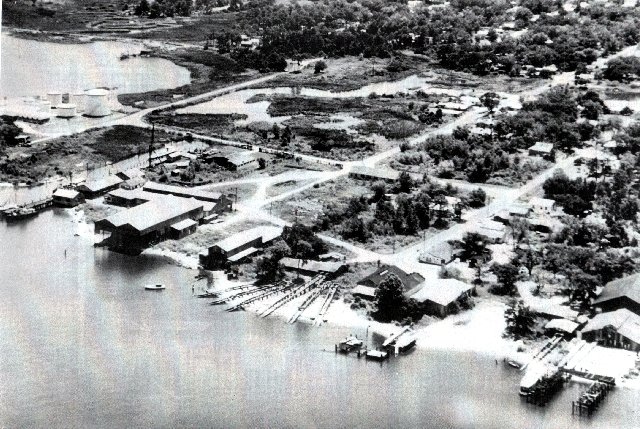
The USS Biloxi (CL-80) was launched 23 February at Newport News, Virginia by Katherine G. Braun (1892-1983), spouse of Biloxi Mayor, Louis E. Braun (1890-1951). Construction began 9 July, 1941.
In February 1943, the Heirs-at-Law of Claudia G. Vick Dacey (1869-1937) and Marguerite Dacey (1900-1942) , executed a one-year lease with an option to purchase to officials of the Westergard Boat Yard, William P. Kennedy II (1873-1951), Victor B. Pringle (1909-1977), Thomas N. Pringle (1906-1970), James W. Pringle (1914-1971) and W.B. Goodman, a co-partnership, on three tracts of land situated on Rhodes Point on the Back Bay of Biloxi. These three contiguous tracts which were bisected by Bayview Avenue ran north for over 800 feet to Back Bay and were for the part 185 feet in width. The lease ran from February 20, 1943 to February 20, 1944 and cost $1200 per year. If the option were executed during the lease period, the Dacey Heirs would sell their three parcels for $8000.(Harrison Co. Chancery Court Land Deed Bk. 255, p. 69)
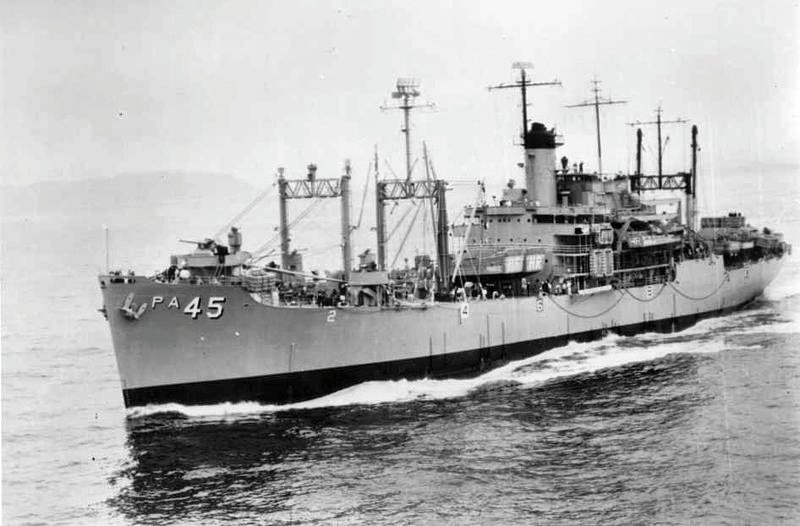
SS Sea Darter, later renamed USS Henrico [APA-45]-image made during Vietnam era
Ingalls Shipbuilding at Pascagoula, Mississippi launched the SS Sea Corsair and SS Sea Darter on March 31, 1943.(The Daily Herald, March 30, 1943, p. 1)
On June 18th, Westergard launched its 2nd, composite oil barge. The $2,000,000 contract called for the construction of thirty oil barges to haul petroleum products from Texas-Louisiana to Jacksonville, Florida via the Intracoastal Waterway. The hydrocarbons were off-loaded to other barges for shipment to cities on the Atlantic Seaboard. The barges were 160 feet long, 34 feet wide, and 10 1/2 feet deep with the capacity for 6000 barrels. James W. Pringle was superintendent of the boatyard and Connie Collins supervised construction.(The Daily Herald, June 19, 1943, p. 1)
The USS Gulfport (PF-20), a 303-foot frigate, was launched on 21 August at the American Ship Building Company yard in Cleveland, Ohio. The vessel was christened by Mrs. John C. Chambers, nee Porter, of Gulfport, Mississippi, the ship's sponsor. Mrs. Pat Harrison Sr. was the matron of honor. During WWII, the vessel served convoy duty between America and North Africa. She was sold for scrap at Seattle, Washington in November 1947.(The Daily Herald, August 27, 1943, p. 1)
The SS Sea Owl was launched at Ingalls on October 29, 1943. (The Daily Herald, October 21, 1943, p. 7)
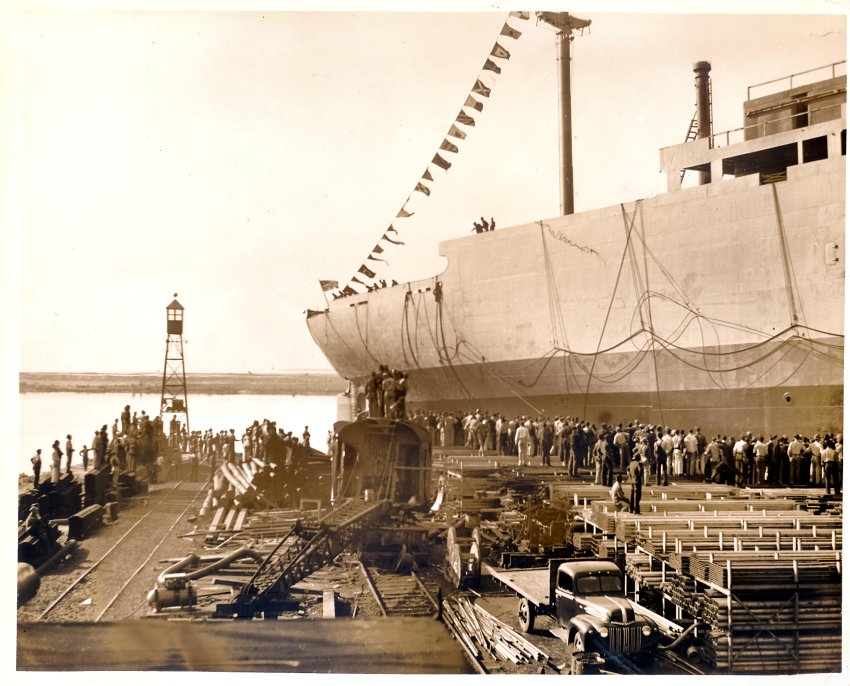
INGALLS SHIPYARD-1940s
The Ingalls Ship Building Company at Pascagoula, Mississippi was praised for its war efforts by the director of the US Maritime Commission.(The Daily Herald, November 4, 1943, p. 3)
William L. Stallings (1895-1943), foreman at the Westergard Boat Works, died suddenly at his home on December 11th.(The Daily Herald, December 13, 1943, p. 2)
The SS Sea Perch was christened and launched at Ingalls on December 17, 1943.(The Daily Herald, December 16, 1943, p. 10)
Ingalls Shipyard at Pascagoula was awarded the Gold Star for its production.(The Daily Herald, December 20, 1943, p. 1)
1944
In late February, Westergard Boat Works launched the USS Pehewah, a 110-foot Navy tugboat. Miss Elizabeth 'Betty' Eileen Burns sponsored the vessel. She was a 1940 BHS graduate and was secretary to Warren B. Goodman, purchasing agent for the boatyard.(The Daily Herald, February 25, 1944, p. 1)
Westergard Boat Works launched another 110-ft harbor tugboat on March 3rd. Betty Burns again broke the champagne bottle on the bow. About 75 workings days are required to fully equip these vessels before they are sent to NOLA for assignement.(The Daily Herald, March 2, 1944, p. 1 and March 4, 1944, p. 6)
Collen C. Scholtes (1917-1996), wife of L. Joseph Scholtes (1917-1994), Westergard Boat Works employee, launched another 110-ft Navy harbor tugboat in March. Two more boats expected to be launched next month.(The Daily Herald, March 20, 1944, p. 6)
On April 8, 1944, the A.W. Covacevich shipyard on Back Bay launched the Matthew Kuluz, a streamlined, cabin, type trawler, for the Kuluz Brothers. A 100 HP Caterpillar engine powered the vessel, which was 58-feet in length, had a 16-foot beam, and hold depth of 4 1/2 feet with the capcity of 180 barrels of shrimp. Marie Kuluz (b. 1933), daughter of Anthony Kuluz (1891-1956) and Annie Mozaro Kuluz (1901-1979), sponsored the shrimp boat. Covacevich has now has two boats under construction: a 52-foot trawler for the Biloxi Canning Company and a 55-foot vessel for Louis Thornton. Frank Broussard, Alex McCaleb, and Gene Ryan assisted A.W. Covacevich in the vessel's vonstruction.(The Daily Herald, April 10, 1944, p. 7)
Marjorie Mounger sponsored the USS Pitchlynn [YTB 283], a 110-foot, 400 ton, Navy harbor tugboat launched in May 1944 at the Westergard Boat Works.(The Daily Herald, May 23, 1944, p. 1)
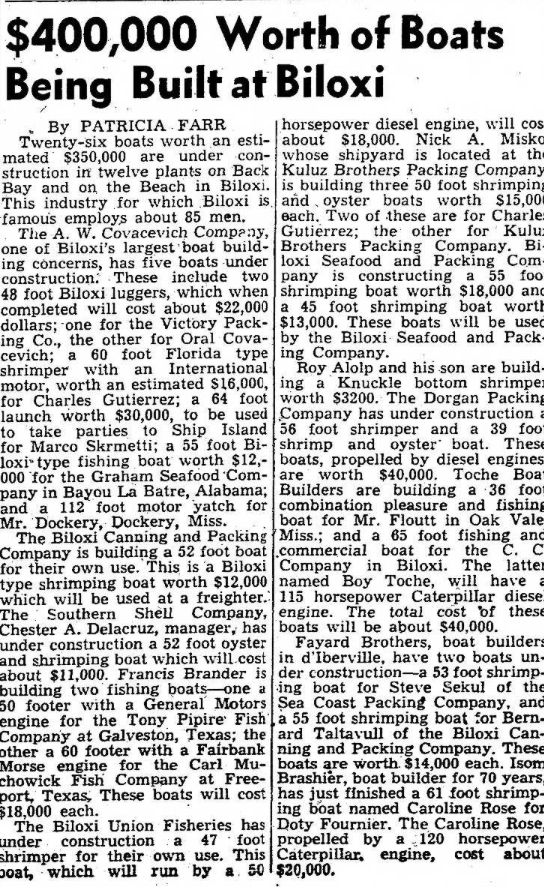
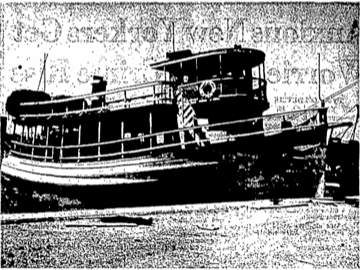

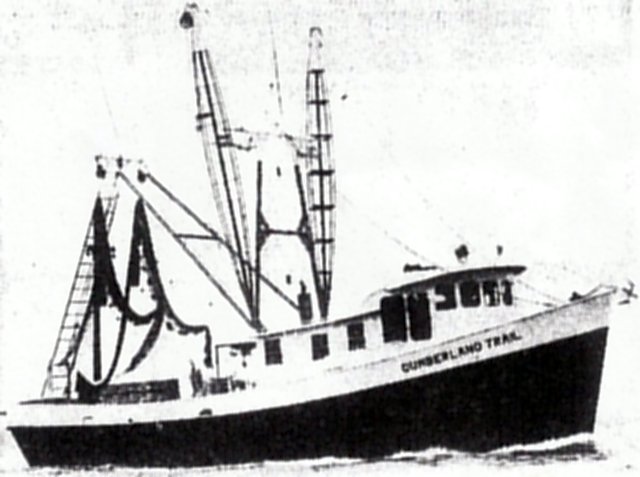
SHIPYARDS
The Westergard Biloxi Boatyard, Incorporated [1941-1945]
The Westergard Biloxi Boatyard, Incorporated, known locally as the Westergard Shipyard, was chartered by the State of Mississippi in March 1941. Axel M. Westergard, Rockport, Texas; Rob Roy Rice Sr., Aransas Pass, Texas; and William P. Kennedy Jr., Biloxi, Mississippi were its original founders. The shipyard was located on Biloxi’s Back Bay at the head of Lee Street and initially comprised about one-acre with a Back Bay frontage of 205 feet.[The Daily Herald, March 28, 1941, p. 9 and Harrison Co., Mississippi Land Deed Bk. 244, p. 177]
The Westergard Shipyard was one of the many military-industrial complexes that were created prior to America’s entry into World War II against Japan and the Axis Powers in early December 1941. Keesler Field and Gulfport Field, both US Army Air Corps facilities, were commenced in 1941.
This shipyard was created to build and repair watercraft for the US Maritime Commission, an entity of the Federal government, which funded and administered the largest and most successful merchant shipbuilding effort in world history, producing thousands of ships, including Liberty ships, Victory ships, and others, notably Type C1, Type C2, Type C3, Type C4 freighters and T2 tankers. Most of the C2s and C3s were converted to Navy auxiliaries, notably attack cargo ships, attack transports, and escort aircraft carriers and many of the tankers became fleet replenishment oilers. The Commission also was tasked with the construction of many hundred "military type" vessels such as Landing Ship, Tank (LSTs) and Tacoma-class frigates and large troop transports. By the end of the war, U.S. shipyards working under Maritime Commission contracts had built a total of 5,777 oceangoing merchant and naval ships. [https://en.wikipedia.org/wiki/United_States/wiki/United_States_ Maritime_Commission]
Ingalls
The only other shipyard of consequence in regards the military on the Mississippi Gulf Coast was the Ingalls Shipbuilding Corporation. In 1938, it was organized by Robert Ingersoll Ingalls Sr. (1882-1951), Robert I. Ingalls Jr. (1906-1968), Monro Bannister Lanier (1887-1970), and W.R. Guest. The Ingalls' yard was situated at the mouth of the East Pascagoula River on the site of the 1917 International Shipbuilding yard of Henry Piaggio (1874-1921) et al.(The Daily Herald, February 25, 1959, p. 10)
In October 1940, Ingalls delivered the first, all-welded, watercraft to the Maritime Commission. It was the SS Exchequer and she was transferred to the Norfolk Navy Yard as a seaplane tender by a Pascagoula crew and renamed the USS Pocomoke [AV9]. By late December 1940 Ingalls had been awarded a $50,000,000, US Navy contract to build four, 500-foot, vessels that were also all-welded, rivetless ships.
Before WW II and ended in 1945, Ingalls Shipbuilding Corporation had launched more than 70 ships.[The Daily Herald, December 20, 1940, p. 1 and R.F. Couch, Journal of Mississippi History, 1964, pp. 192-200]
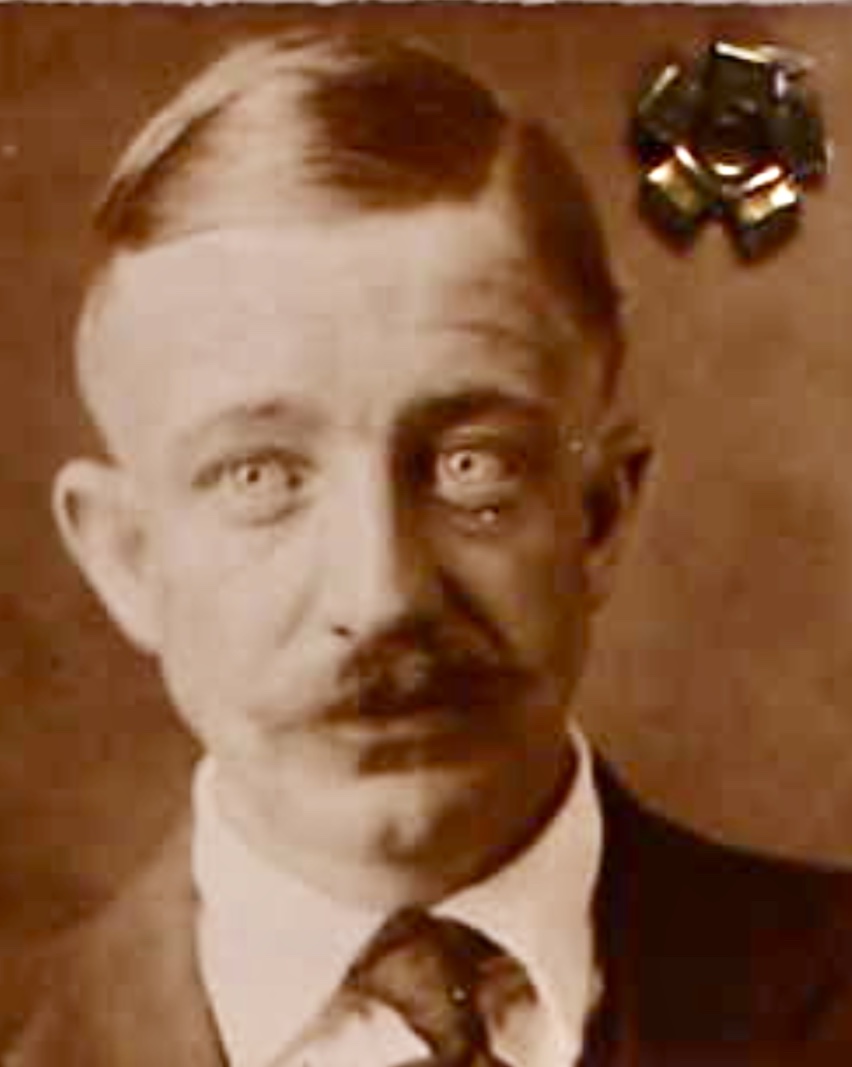
A.M. Westergard
Axel Munch Westergard [1889-1954] was born in Halden [Frederikshald], Viken County, Norway on April 3, 1889. He entered the United States in January 1907 at El Paso, Texas and found his way to San Pedro, California were he made his livelihood as an independent boat builder at Terminal Island, California. Here Axel married Addie Armida McVay [1867-1941], a native of Atlanta, Georgia and the widow of Mr. Hart, and mother of Olive M. Hart.[WW I Draft Registration-Los Angeles, 1917]
In addition to his involvement with the Biloxi shipyard, A.M. Westergard was associated with the Westergard-Rice Brothers and Company shipyard at Rockport, Texas and the Brownsville Shipbuilding Corporation at Brownsville, Texas.
Brownsville, Texas
Before February 1942, Mr. Westergard had resigned from Westergard-Rice Brothers and Company to devote his full time with his Westergard Boatworks in Brownsville, Texas.[The Aransas Pass Progress, February 19, 1942, p. 1]
At Brownsville, A.M. Westergard was called Captain Westergard and titled naval architect and marine engineer. This shipyard’s first military contract was for $400,000 and let by the US Army Air Corps to build four, triple screw, offshore aircraft rescue ships. These watercraft were 105-feet in length and drew 6-feet of water. Power was supplied by 600 hp gasoline engines.[The Brownsville Herald, November 22, 1941, p. 1]
Ocean Springs, Mississippi was selected as a “Crash Boat’ Base site by the US Army Air Corps. The facility was a sea-going emergency, rescue operation located on the south side of Hellmer's Lane and on the northwest shore in the Inner Harbor at Ocean Springs, during the final years of WW II. It was manned by personnel of Squadron V, 3rd Air Force Bomber Command, US Army Air Corps from the Gulfport Army Air Field at Gulfport, Mississippi. The base was erected in early 1944, to house crash boat officers and crews as well as ancillary personnel who manned the small post. The mission of the local boat base was to rescue downed aviators, tow targets, and patrol bombing ranges in the Mississippi Sound and Gulf of Mexico.[US Air Force Historical Agency, Maxwell AFB, Alabama and The Jackson County Times, January 15, 1944]
R. R. Rice
Rob Roy Rice [1896-1972] was born in Apalachicola, Florida to Captain Stephen E. Rice [1838-1919] and Emily Irvine Pickett [1848-1938], both Alabama natives. He married Emily Clara Buzhardt [1887-1944] a South Carolinian, in Franklin County, Florida in December 1909. Four sons were born from this union: Rob Roy Rice Jr. [1910-1989]; John Chapman Rice [1914-1993]; Steppie Irving Rice [1915-1985] m. Joseph F. House and Bryson M. Filbert [1915-1990]; and Joel Key Rice [1924-2005]. The Rice children were all born at Apalachicola, Florida. In Florida, R. R. Rice was an oyster canner. Circa 1926, the family relocated to Rockport, Texas, near Corpus Christi, and opened a seafood cannery specializing in shrimp processing.
R.R. Rice with his son, Rob Roy Rice Jr., Judge J.A. Steele and A.F. Buchanan of Rockport, Texas formed Rice Brothers and Company after the departure of Mr. Westergard for his Brownsville shipyard. Their success at Rockport was assured in early 1942, when the US Maritime Commission ordered an additional eight, submarine chasers. At this time, the Navy Department also laude the Rice Brothers boat works by awarded them the Navy Blue “E” Pennant for their progress, quality of workmanship, safety, and general morale.[The Aransas Pass Progress, February 19, 1942, p. 1]
W. P. Kennedy Jr.
William Patrick Kennedy Jr. [1905-1967] was a native Biloxian and the son of William P. Kennedy Sr. [1873-1951] and Fantie Wright Kennedy [1876-1969]. He married Beatrice Hardisty [1906-1995], a native of Illinois. Their children were: Mabel ‘Patti’ Kennedy [1924-2015] m. William E. Courson [1922-1989] and Edward J. Bellman [1920-2009]; William P. Kennedy III [1926-1975] m. Josephine Kelly [1930-2008]; Thomas Morgan Kennedy [1928-2010] m. Jane Vickery [1930-1998]
Mr. Kennedy was an early Biloxi entrepreneur having experience in real estate, as well as animal husbandry and gardening with the Bay Flour and Seed Company. He is perhaps more familiarly associated with the Kennedy Brothers Engine Company and Kennedy Engine Company.[The Daily Herald, June 30, 1967, p. 2 and http://kennedyengine.com/history]
Biloxi Boatyards
Although Biloxi was never a major shipbuilding center, it has been noted for its wooden boat construction since Colonial times. In December 1720, Jean-Baptiste Le Bouteux, French artist, created a sketch of Nouveau Biloxy [New Biloxi] illustrating the camp of the John Law Concession. Among the many activities of the French colonists is wooden boat construction. A small barge or skiff and a chaloupe or biscayenne are two of the watercraft depicted by Le Bouteux.[Copy Biloxi Public Library]
As Biloxi grew from a village to become ‘the Sea Food Capitol of the Planet’ in the dawn of the 20th century, fishing schooners and ancillary watercraft were in demand. 19th century Spanish immigrant families from Spain and the Balearic Islands had established shipyards on Back Bay’s north shore. Among them were: Foretich, Sanchez, Taltavull, Quave, Perez, Santa Cruz, and Cannette. The Fountain and Harvey [Hervai] families of French descent also proved to be capable craftsmen for Biloxi’s shipbuilding industry. In later times, Herman Kelly and the Brasher brothers, Henry and Isom, made valuable contributions to the local fishing fleet with their swift schooners.
By the 1920s, the majority of Biloxi’s boatbuilding industry had located to the Biloxi Peninsula with shipyards on Back Bay and Point Cadet. Back Bay from Lameuse Street to Oak Street featured ship carpenters like Fred Moran; Henry and Martin Fountain Jr.; Anson Holley; J.C. and Francis Brander; Jules Galle; the Frentz Brothers; and U.A. Parker. On Point Cadet, the Toche Brothers, were the primary boat builders. Louis Gorenflo and Zona Carter on West Beach were building specialty watercraft on a small scale on land lots.
During and after WW l, probably the largest wooden boats ever built at Biloxi were constructed on Back Bay. The Elizabeth Ruth, a 193-foot schooner, was launched on 15 June 1918. Catherine Lopez, daughter of Julius Lopez had the honors. The large vessel was built by the Mississippi Shipbuilding Corporation and designed by Zona W. Carter (1879-1953), a Biloxi resident, and named for the daughter of Englishman William Hasketh Lever (1851-1925), Lord Lever, founder of soap manufacturers, Lever Brothers.(The Daily Herald, June 12, 1918, p. 1, June 15, 1918, p. 1. and June 17, 1918, p. 3)
In January 1919, the Joseph Leopold, a four-masted, schooner built for J.F. Stewart of Gulfport was measure by Customs Agent Lewis Curtis as follows: length-180 feet; beam-38 feet; and depth-13 feet; gross weight-668 tons; net weight-573 tons. The Joseph Leopold was built by J.D. Covacevich at the Biloxi Shipyard and Box factory on Back Bay.(The Daily Herald, January 23, 1919, p. 1)
Biloxi Port Commission-founded 1940
Before any military watercraft could be built at Biloxi, obviously for our entry into WW II or for loan to our European allies, England and France, it was necessary that a Port Commission be created to manage the erection and supervision of port facilities and insure that a deep-water channel be dredged to provide sufficient water depth for naval vessels to operate. A $100,000 bond issue to finance the deepening of the present Back Bay channel was a salient issue in regards winning future military contacts.[The Daily Herald, April 25, 1940, p. 1]
To establish a Port Commission, it was necessary for the Mississippi State Legislature to adopt a resolution submitted by local representation. At this time, Howard A. McDonnell [1909-1992], a Biloxi attorney, criminologist, and recently elected Floater Representative for Harrison County and Jackson County, was delegated this task.
The newly created Biloxi Port Commission had its first meeting on September 25, 1940 at the Baltar Realty office. Members were: John E. Swetman [1867-1958]; R. Hart Chinn, appointed by Paul B. Johnson, Governor; and Jacinto Baltar, appointee of the Harrison County Board of Supervisors.(The Daily Herald, September 25, 1940, p. 2)
New Management Team
In March 1941, although retaining the name Westergard, the management of the nascent shipyard came under local control when Axel M. Westergard, Rob Roy Rice and Frank Kennedy resigned and relinquished their stock holdings. The new officers of the imminent Biloxi shipyard were: William P. Kennedy Jr., president; Thomas Pringle, vice-pres.; and Victor B. Pringle, secretary-treasurer.
Growth and Inflation
With the news of a potential US Army Air Corps field to be located in the Naval Reserve Park and the Westergard Biloxi Boat Works in the process of initiating construction, Biloxi’s small town atmosphere began a metamorphosis. Was an uber boom about to commence? With a population of about 17,000 people, Biloxi could soon expect a large work force approaching 12,000 people to descend and change it forever. A US Army engineer from Ohio was quoted as: “In the face of present situation, Biloxi hasn’t got enough saws and hammers in its hardware stores. No matter how much stock its other stores have it is not going to be adequate. I don’t care how many cots your hotels have they haven’t enough.” In anticipation of the coming flow of people and dollars, local barbers on April’s Fools Day raised the price of adult haircuts to 50 cents and 35 cents for children. The tonsorial aficionados were no fools![The Daily Herald, March 26, 1941, p. 7]
Building the Boat Yard
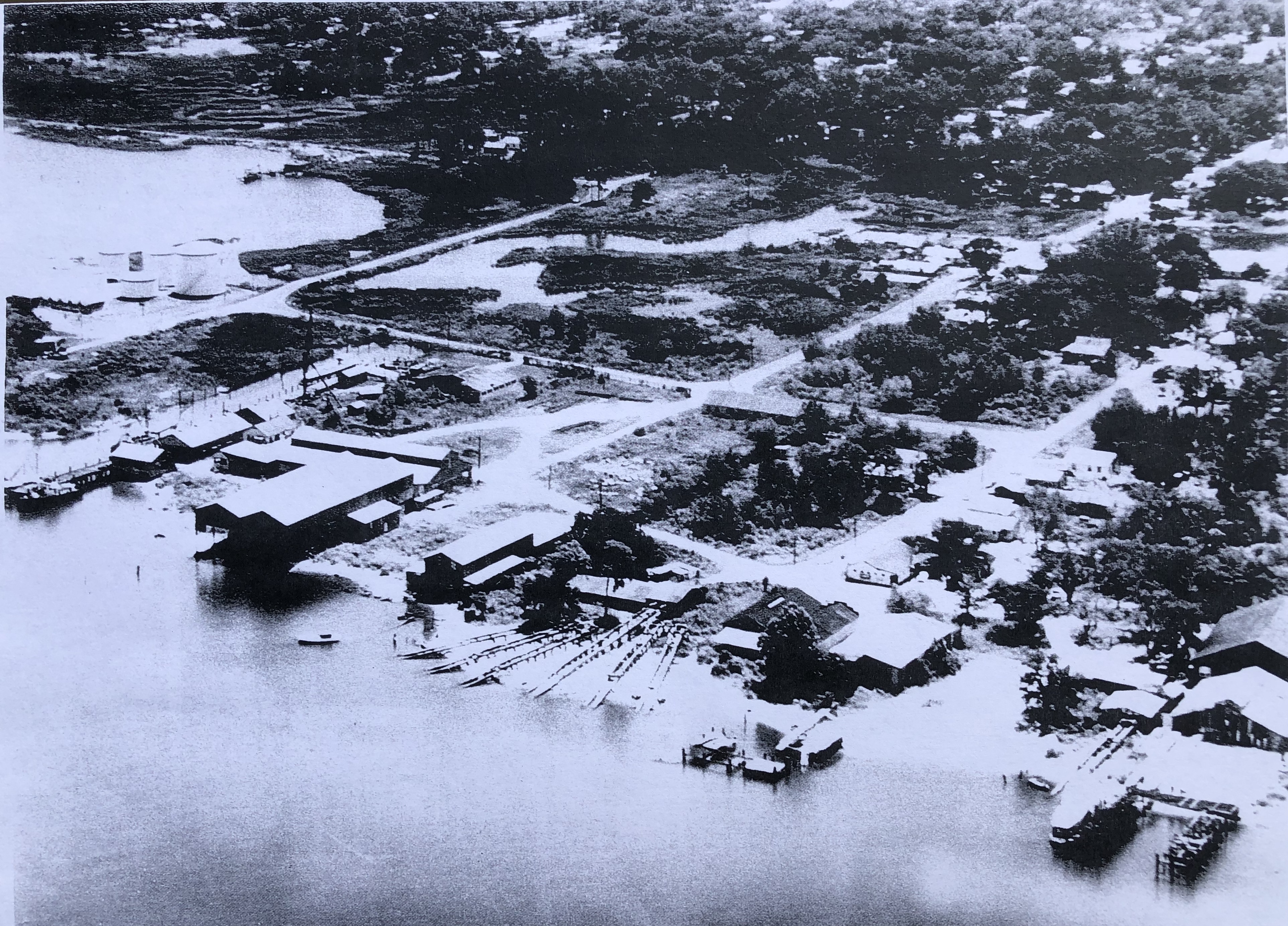
Westergard Biloxi Boat Works
This local shipyard was created from bare ground in the spring of 1941 with local management and labor and was able to produce for the "Splinter Fleet", wooden boats, for the US Navy and lend lease Allies, France and England. Located on Biloxi's Back Bay near Lee Street, the yard produced Sub Chasers, Sea going Tug Boats and Mine Sweepers before it closed in August 1945. From October 1941, the boat yard had built for the US Navy: two submarine chasers-$300,000; ten mine sweepers-$4,000,000; and four harbor tugs-$1,500,000. For the US Army, the shipyard had built eighteen oil barges-$1,020,000. In addition, three, steel, trawlers were erected for the seafood industry-$25,000. During its almost four years of production, the facility had a payroll exceeding $4,000,000 and employed about 500-700 Biloxians who worked on construction contracts exceeding $7.5 million. William P. Kennedy Jr. [1907-1967], Biloxi native, was president of the organization.
In early April 1941, the preparation and clearing of the site for Biloxi’s newest shipyard was hampered by large blocks of concrete left there when the 1926 Biloxi-D’Iberville was erected. Dynamite was used to demolish and reduce the size of the relic materials leaving the air vibrating with loud and obnoxious noise![The Daily Herald, April 10, 1941, p. 2]
The Biloxi Port Commission accepted the $43,322 bid of general contractor, Currie & Corley of Hattiesburg, Mississippi, to erect a steel building [$18,486] to be used as a boat plant at the foot of Holly Street [sic] on East Back Bay. Albert J. Ragusin was awarded the plumbing contract [$3549]; Ray V. Pisarich, electrical [$1522]; and roofing [$1365] to Biloxi Roofing and Sheet Metal.(The Daily Herald, April 16, 1941, p. 1)
By mid-September, the 16-month efforts of the Biloxi Port Commission and from city officials and leading Biloxi citizens were nearly realized with the completion of the Westergard Biloxi Boat Works on Back Bay at the foot of Lee Street. I. Daniel Gehr (1895-1959), local architect, supervised the construction of the warehouse, fabricating building, loft and drafting buildings, general offices, and work sheds. The larger structures were of fabricated steel construction with concrete foundations while the smaller buildings were modern, frame structures. Currie & Corley of Hattiesburg, Mississippi was the general contractor while other employed to erect the shipyard were: Iron Steel Products Company; Albert J. Ragusin-plumbing; Ray V. Pisarich, electrical; and roofing-Biloxi Roofing and Sheet Metal. The Jackson County dredge dug the channel into the boatyard, which now had a 400-foot frontage on Back Bay. The Port Commission had paid Currie & Corley $43,322 for their efforts. (The Daily Herald, April 16, 1941, p. 1 and September 20, 1941, p. 3)
US Navy Contracts
In early September 1941, the US Navy awarded Westergard Boat Works a contract to build two wooden vessels, both Submarine Chasers. They would be named USS PC 650 and USS PC 651(The Daily Herald, September 19, 1941, p. 1)
Union Contract
On 22 October 1941, William P. Kennedy Jr., president of the Westergard Boat Works of Biloxi, Incorporated completed a two-year, closed shop, all-union contract with officials of the American Federation of Labor. This agreement set pay scales as follows: skilled craftsmen-$1.07 per hour; labors-$.50 per hour; apprentices-$.54 cents per hour for the initial year and an increase of $.05 cents per hour every 6 months thereafter. The work week was 40 hours and overtime payment was 1 and ½ times regular wages.[The Daily Herald, October 23, 1941, p. 6]
Labor Force
The majority of the workmen who built ships, harbor tugs and oil barges at the Westergard Biloxi Boatyard were native Biloxians and from surrounding communities. Many were ship carpenters and fishermen who in a show of patriotism joined the cause to defeat the Axis threat in Western Europe.
James Briley “J.B.” Richmond Sr. [1925-2014], Biloxi entrepreneur, published a thorough study of the Westergard Biloxi Boat Works in 2009 titled, “World War II Combat Wooden Boats Built at Biloxi Westergard Boat Works of Biloxi, Inc.” Researched in detail it is the salient, historical source for this shipyard. Thank you Mr. Richmond for your contribution to Biloxi’s maritime chronology.
Per Mr. Richmond, the Westergard Boat Yard was organized as follows:
General Superintendent: Anthony W. ‘Tony Jack’ Covacevich [1907-1997]. Assistant, Neil Covacevich [1920-2007].
Paint Shop: Bowman Brodnax [1907-1991] and Mack Hall [1917-1952]
Machine Shop: William ‘Bill’ Hubbell [1902-1983] and assistants: George Williams; Willie Dale [1899-1990]; Joe Scholtes [1917-1994]; and Frank Duvic [1900-1974]
Caulkers: Fred Frentz [1895-1964] and assistants: Anthony Fountain; Joe Ables; Leon Dalgo [1896-1953]; Joe Montgomery [1892-1972]; and Eddie Moran [1886-1960].
Loft Hull Layout: Zona W. Carter [1879-1953] and Kenneth P. Trochesset [1918-1990]
Electrical: C. Arnold ‘Skinny’ Davidson [1901-1971]; J. Wesley Compton [1920-1995]; and James ‘Jimmie’ Cook [1920-1997]
Heavy Timbers, Keels, Beams, Stringers and Clamps: J.D. ‘Jack’ Covacevich [1875-1962]; Martin Fountain Jr. [1882-1963 Earlis Champaigne [1928-1981]; Joe Trochessett; and Louis Manuel.
Mill Cabinet: Henry Manuel [1896-1968]; Jesse Wells [1910-1963]; Willie Crabtree [1903-1972]; L. B. Camp; Uriel Ray Kennedy [1917-1995]; and Frank Broussard.
Planking: Henry Fountain Sr,; Charles Trochessett; Jerry Burdine; George Burton; Curtis Fountain; Fitz Fountain; Elvin Cannette; Anthony Pickich Jr.; Melvin Roberts; “Sox” Fountain; Wilfred Fountain; “Son” Moore.
Tool Shop: Eddie Thomas
Planner: Randolph Fountain
Lumber Checkers: Percy Garner
Security: Pop Walker
First Aid: William P. Kennedy Sr. and Dr. Riley Burnett.
Keels Laid
The Westergard Biloxi Boat Works laid the keel for a US Navy submarine chaser on 21 October 1941. The second submarine chaser of the two-boat Navy contract was commenced in early November 1941. Frederick D. Lawley(1878-1953), Boston naval architect, designed the vessels. The work was supervised by Navy Commander G.W. Thompson from the Ingalls Shipbuilding Corporation [Pascagoula]. Biloxi resident supervisor was Leonard Mallory, formerly Captain of the North Wind, yacht of NOLA cinema magnate F.V. Richards.(The Daily Herald, October 22, 1941, p. 1 and November 5, 1941, p. 1)
1942
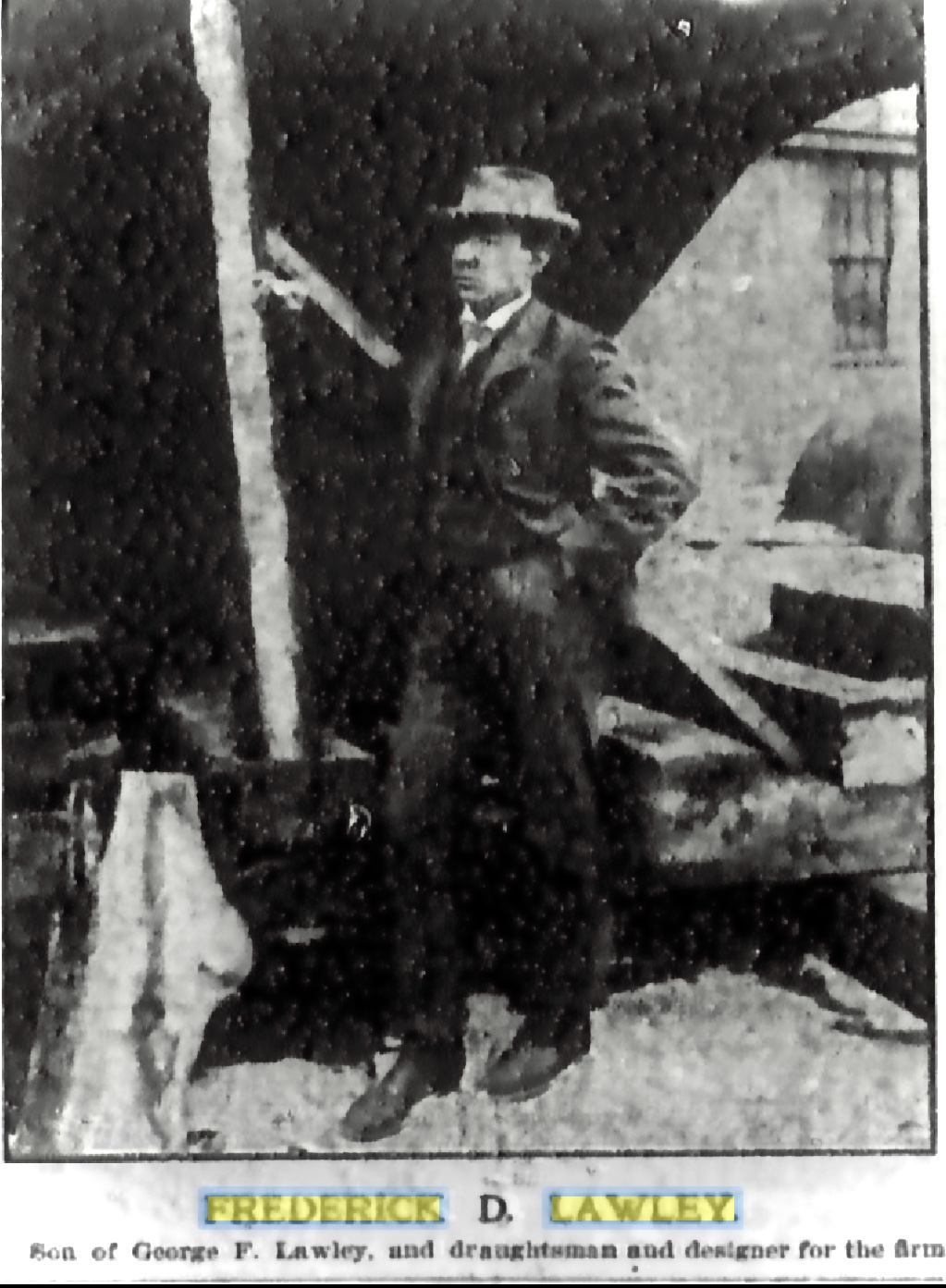
Frederick D. Lawley
By May 1942, Frederick Damon Lawley, a naval architect and 1900 graduate of the Massachusetts Institute of Technology [MIT], had arrived at Biloxi with his spouse, Minnie Josephine Cole [1879-1965]. Both Boston natives, they settled into the Tivoli Hotel. Mr. Lawley was of the third generation of prominent Massachusetts boat builders. George F. Lawley Sr. [1823-1915], English grandfather, and George W. Lawley [1862-1940], father, had started the George Lawley & Son Shipbuilding in 1866. The yard closed in 1945. Of note is that the Lawley’s built two defenders of the America Cup, Puritan [1885] and Mayflower [1886].[The Boston Herald, December 24, 1953 and The Boston Traveler, January 7, 1965]
USS SC 650
Westergard launched its first combat craft, the USS SC 650, a 110-foot, Submarine Chaser, on April 30, 1942. Victor B. Pringle, Master of Ceremonies, related that this Navy vessel was the first combat ship ever constructed at Biloxi. The traditional champagne bottle was cracked across the bow officially send the ship down the ways into Back Bay. Mrs. William P. Kennedy Jr. was the honored launcher. Biloxi dignitaries present were Mayor Louis Braun and R. Hart Chinn of the Port Commission. The Navy was represented by : [The Daily Herald, May 1, 1942, pp. 1-3]
The keel for the first of ten minesweepers was laid on 30 April 1941.[The Daily Herald, May 1, 1942, p. 1]
USS SC 651
The second, 110-foot, Submarine Chaser the USS SC 651 was launched on May 14, 1942 in a low-key ceremony by Minnie J. Cole Lawley [1879-1965], spouse of Frederick ‘Fred’ Damon Lawley [1878-1953], naval architect and superintendent of construction at the Biloxi shipyard. Victor B. Pringle was master of ceremonies. Biloxi dignitaries present were Mayor Braun and R. Hart Chinn of the Port Commission. The Navy was represented by Lt. Commander G. C. Whiting of Pascagoula and Captain L.S. Border. Superintendent F.D. Lawley gave a short speech. [The Daily Herald, May 15, 1942, p. 5]
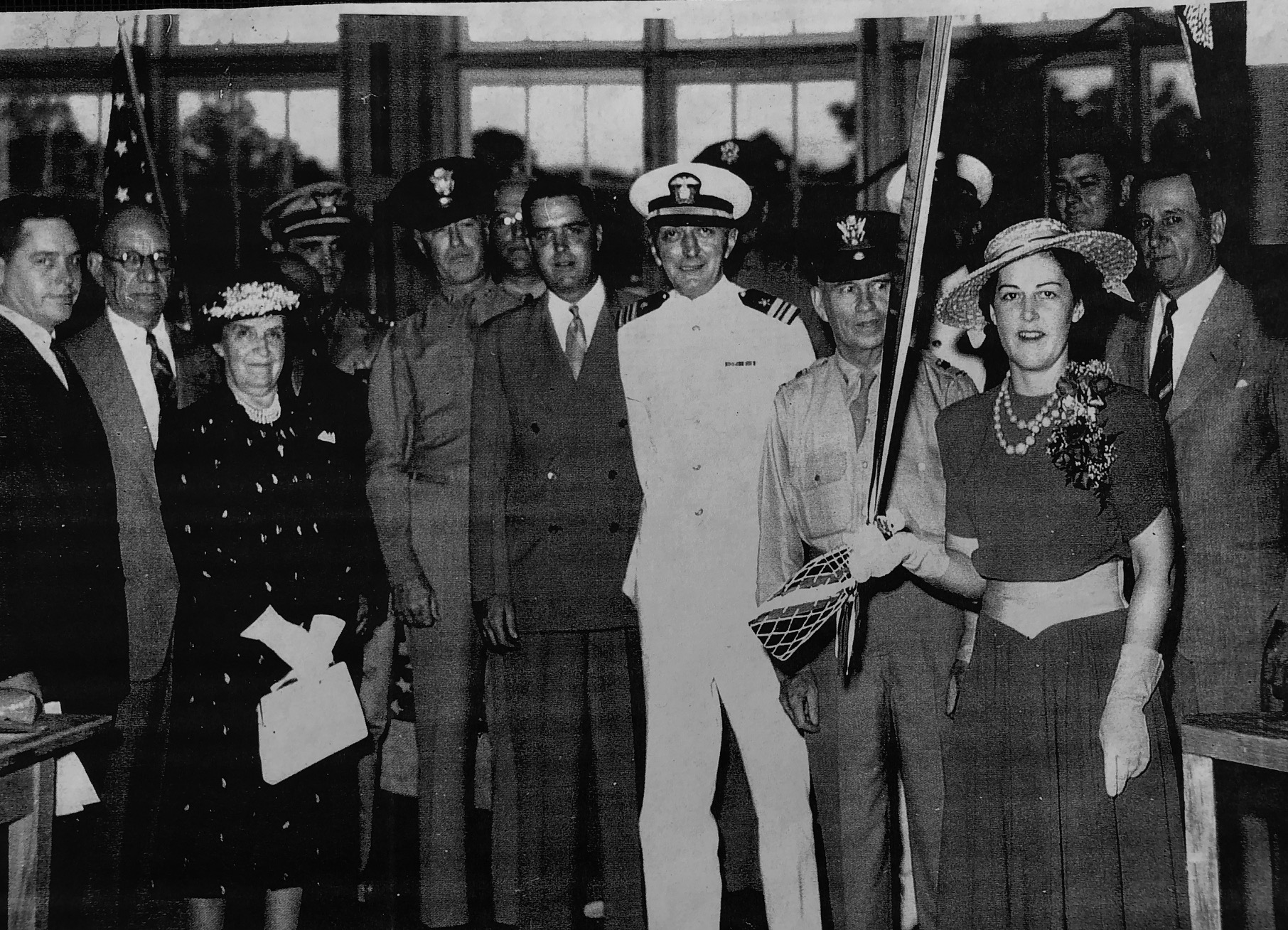
Launching USS PC 650
On April 30, 1942, this 110-foot, submarine chaser was first combat ship to be constructed at Biloxi. It was sent down the ways into Back Bay from the Westergard Biloxi Boat Works by Beatrice Hardisty Kennedy [1906-1995], spouse of the companies president, William 'Big Bill' P. Kennedy Jr. [1907-1967]. This small but industrious boat yard would by 1945 build submarine chasers, minesweepers, harbor tug boats and oil barges for the American armed forces and their European allies. Manned chiefly by indigenous boat carpenters and fishermen, Westgard's laborers and management would be recognized by the USN several times with its "E" Pennant, in recognition for its excellent construction. [L-R: Victor B. Pringle; Frederick Damon Lawley; Minnie J. Cole Lawley; Lt. Lindholm; Col. Arthur E. Brock Jr.; R. Hart Chinn; Thomas Pringle; Lt. Comm. F.F. Daly; Col. William J. Hanlon; Col. Robert M. Goldrick; Lt. Comm. G.C. Whiting; Beatrice H. Kennedy; William P. Kennedy Jr.; Biloxi Mayor Louis Braun.
1942
The Navy ‘E’ Pennant
Westergard Biloxi Boat Works was recognized by the 8th District Naval Headquarters on several occasions for its excellence in constructing naval combat vessels and oil barges with efficiency and celerity. The first kudo from the US Navy occurred in February 1942 when Frank Knox, Navy Secretary, telegrammed the management that “on this occasion of the award of a special recognition of your outstanding accomplishment in war time shipbuilding for the United States permit me to offer congratulations and profound thanks to the men and management of the plant.” The Navy ‘E’ Pennant was sparsely awarded because of its high standards. At this time, only 16 companies of the US Navy's 174 defense contractors had received the honor.[The Daily Herald, February 16, 1942, p. 9 and February 19, 1942, p. 1 and p. 6]
On December 1, 1942, the Westergard Boat Works was again recognized by the US Navy for its excellence in building boats and barges. 8th District Naval Headquarters awarded the plant with the Navy ‘E’ Pennant with two white stars. Each white star affirmed that the shipyard had continued their excellence an additional six months.[The Daily Herald, November 30, 1942, p. 6 and December 8, 1942, p. 1]
In February 1943, Victor B. Pringle [1909-1977], Westergard’s secretary and perennial master of company held ceremonies, proudly related to the audience that the plant again had been recognized by the US Navy for its efficiency and workmanship and presented with another US Navy ‘E’ Pennant. The occasion was the launching of BYMS 2059, its fifth minesweeper.[The Daily Herald, February 9, 1943, p. 1]
The work force at Westergard continued its excellent wok and the Navy ‘E’ Award arrived again in August. Admiral C.C. Block wrote to W.P. Kennedy Jr. as follows: “The men and women have received a signal honor by continuing their splendid production record. The management and employees of the plant have indicated their solid determination and abilities to support our fighting forces by supplying equipment needed for the ultimate victory.”[The Daily Herald, August 26, 1943, p. 1]
In May 1944, the fourth star was added to Westergard’s US Navy ‘E’ Pennant for meritorious services and high standards in shipbuilding.[The Daily Herald, May 13, 1944, p. 1]
Biloxi Defense Vocational School
On July 4, 1942, the new vocational school was dedicated at the Porter Avenue campus. The intent was to provide youths 18 years and older with the opportunity to learn manual skills needed at the Westergard Biloxi Boat Works. Initially, three disciplines were taught pro bono: carpentry, sheet metal fabrication and marine pipefitting. Ship carpentry classes with the capacity for 80 students per day were held in the Biloxi High School gym and the discipline taught by F.A. Moran and R.F Chambers. The Sheet metal shop was led by D.C. Rutledge. It could accommodate 60 men daily for instruction. Marine pipefitting was under the supervision of A.F. Cauzabon and A.L. Jacquet. The course was limited to 72 men daily. These courses were held on Porter Avenue in what had once been the West End School, but now used by the American Legion.[The Daily Herald, July 3, 1942, p. 2]
For an unknown reason, this initial effort at Biloxi’s manual training school did not work. In early September 1942, Leonard Mallory [1899-1970], Navy inspector, W.P. Kennedy Jr., Westergard, president, George W. Ditto [1895-1975] Biloxi school superintendent, and C.L. Charbonneau of the State Department and foremen and leaders from the shipyard met and discussed and planned to reorganize the vocational training effort. A new school was planned with the following courses of instruction: ship carpentry and blue printing reading as related to carpentry, shipboard electrical circuits and pipefitting. Classes were open to Biloxians and current Westergard employees who wanted to learn another manual discipline. Mr. Charbonneau left the group with this caveat; equipment now in Biloxi has a value of $6000. If it is not utilized immediately it will be shipped to another location.[The Daily Herald, September 10, 1942, p. 7]
Response to the re-opening of the vocational school was very positive. More than 50 interested individuals, most of them employees of Westergard, demonstrated an interest in enrolling in the program. Registration was held on 15 September with classes meeting 2 1/2 hours in the evening three nights each week.[The Daily Herald, September 14, 1942, p. 10]
In mid-September Director Leonard Mallory announced that the Defense Vocational School would now offer women, eighteen years and older, the opportunity to learn a skill associated with the war effort. Blueprint reading, a special course in tracing and blueprint interpretation, would be taught three nights each week at the Lopez Elementary School on West Howard Avenue. A minimum of 15 applicants were required to commence a new class. Jesse L. Weeks, an employee of Westergard, would instruct the ladies. In addition Mr. Mallory related that school had 42 men engaged in the ship carpentry class and 47 in the advanced blueprint reading class for shipboard pipefitter and electricians.[The Daily Herald, September 17, 1942, p. 6 and September 25, 1942, p. 19]
In early December 1942, Leonard Mallory [1899-1970], director of the school, announced that a new class, ‘Machine Shop Practice’, would be offered. He cautioned the public that with the paucity of interest in this facility that this might be the last attempt to provide a free vocational education to young Biloxians. Instructors selected were Leon Joseph ‘Joe’ Scholtes [1917-1994] and James R. McElroy [1886-1963], both local and well-respected machinists, and also in the employ of Westergard. The instructions were presented at the American Legion Hall on Porter Avenue in such a manner that any student after completing the 75 hours of class time could be hired as a machinist helper. McElroy and Scholtes intents was to share their extensive knowledge of the following: tool handling; how to set up machinery in the shop; sharpening and grinding of cutters; measuring as applied to machines; pipefitting and fabrication; boiler making; and blueprint interpretation.[The Daily Herald, December 5, 1942, p. 3]
Only 11 people enrolled in the ‘Machine Shop Practice’ class at the Legion Hall on Porter Avenue. More students were anticipated as entry level positions in the machine shop at Westergard and elsewhere were in demand. Among the enrollees were: L.E. Capuano; Otis Cates; R.P. Cox; E.J. DeRouen; R.P. Eskald; Curtis R. Harrison; Herron Kennedy; Elliot Miller; Norman Schonewitz; Albert Strangi; and Rambaut Williams. The classroom was equipped with lathes, grinders, drill presses and other machine shop tools germane to the education of an apprentice in this field of endeavor. Westergard furnished rough stock and other materials to the school in appreciation for the efforts of local educators to provide this service to the community. [The Daily Herald, December 8, 1942, p. 8]
When the boat building class, also situated in the American Legion Hall, finished its first project, the Legionaires donated it to the local Boy Scouts.[December 8, 1942, p. 8]
Plant Expansion
In September 1942, with continued development at the shipyard, Westergard petitioned the Army Corps of Engineers at Mobile to erect two boat launching ways. The se structures were 12 feet wide and extended about 150 feet in Biloxi’s Back Bay.[The Daily Herald, September 18, 1942, p. 7]
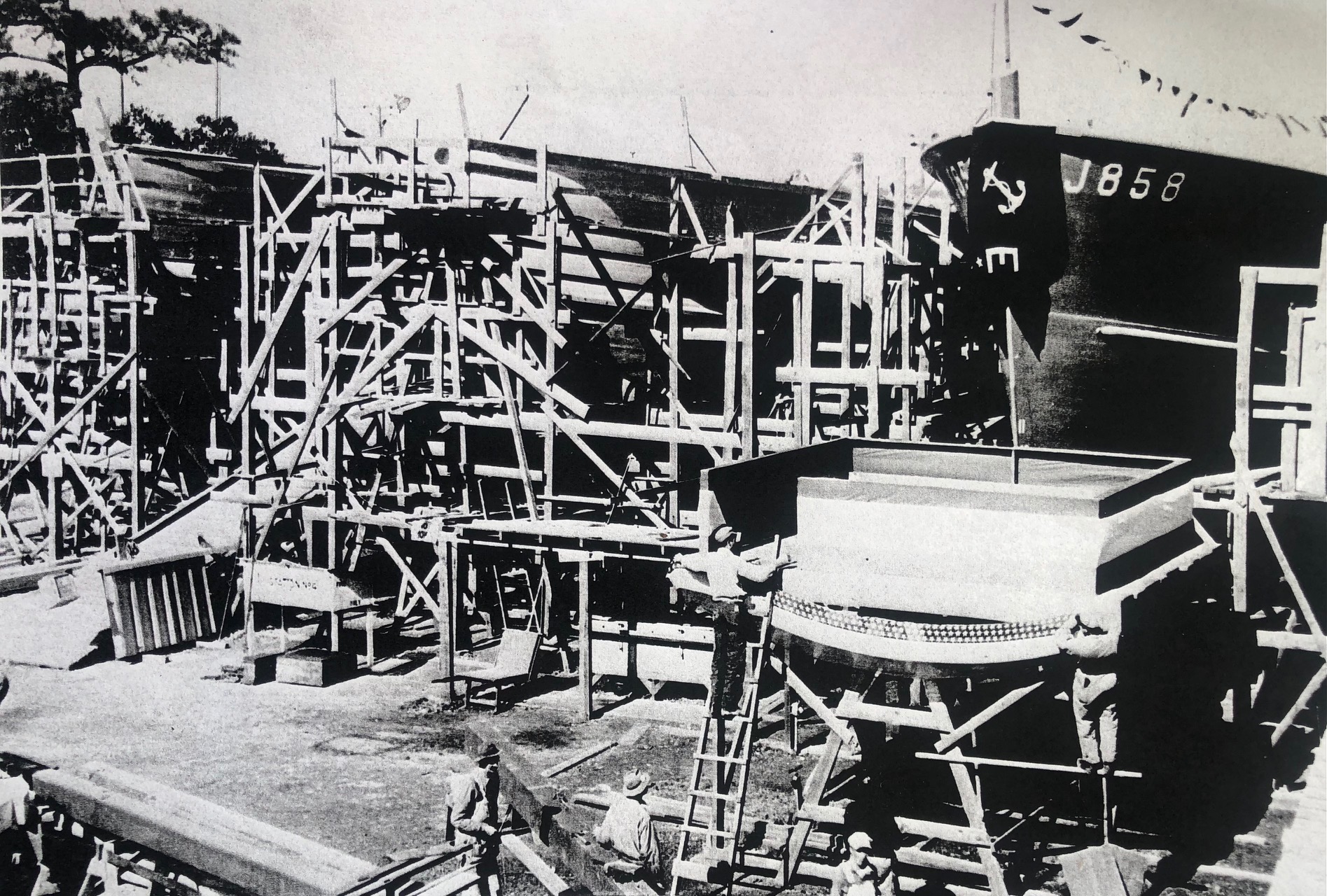
The Navy ‘E’ Pennant-Westergard Biloxi Boat Works was recognized by the 8th District Naval Headquarters on several occasions for its excellence in constructing naval combat vessels and oil barges with efficiency and celerity. The first kudo from the US Navy occurred in February 1942 when Frank Knox, Navy Secretary, telegrammed the management that “on this occasion of the award of a special recognition of your outstanding accomplishment in war time shipbuilding for the United States permit me to offer congratulations and profound thanks to the men and management of the plant.” The Navy ‘E’ Pennant was sparsely awarded because of its high standards. At this time, only 16 companies of the US Navy's 174 defense contractors had received the honor. Note the Navy 'E' Pennant drapped across the bow of J 858, a minesweeper, almost ready for launching into Back Bay. Workmen are preparing the dedication platform in anticipation of the future occasion.
Third Boat Launching
The first anniversary of the Japanese attack on Pearl Harbor saw Margaret Woodley Pringle, [1911-1997], wife of Victor B. Pringle, Biloxi attorney, Westergard investor and master of ceremonies at the shipyard’s public functions, christen BYMS 2055, the first of ten minesweepers built at the Westergard plant. These wooden watercraft participated in Operation Overlord, the June 1944 invasion of Normandy, by clearing the English Channel of German mines.[The Daily Herald, December 8, 1942, p. 1]
Mayor Braun appreciated
In mid-December, outgoing Mayor Louis J. Braun (1890-1951), was presented a 1941 Plymouth coupe and war bonds by James S. Love Jr., manager of the Buena Vista and White House Hotels, in appreciation for his outstanding service to the City of Biloxi during his recent term. During Braun's four years as Biloxi's Mayor the citizens saw the following accomplished: Keesler Field; Biloxi Community House; USO Building; Westergard Boat Works; a two-lane Beach Drive; a new sewer and water works system; and the filling-in of low lands in eastern Biloxi with channel spoil.(The Daily Herald, December 16, 1942, p. 1)
Twin Launching
Westergard experienced its first dual launch on 15 January 1943. Sponsors for the watercraft were Nell Goodman [1905-1995], spouse of Warren B. Goodman [1901-1971], and Marjorie Robertson of Chicago. She was the sister of Lt. Hugh Robertson Jr., USN.[The Daily Herald, January 16, 1943, p. 1
1943
Minesweeper Launched and Navy ‘E’ Pennant
Westergard had its fifth minesweeper launched in early February. Victor B. Pringle, perennial master of ceremonies, proudly related to the audience that the plant again had been recognized by the US Navy for its efficiency and workmanship and presented with another US Navy ‘E’ Pennant. Helen Harvey Hubbell [1905-1989], a schoolteacher and spouse of William F. Hubbell [1902-1983], supervisor of the yards machine shop, was the honoree of the champagne bottle.[The Daily Herald, February 9, 1943, p. 1]
Oil Barges
In mid-April 1943, a $2 million dollar boat contract was announced by Westergard’s management. The Army Engineers at Philadelphia had requested that 30 composite oil barges be built by the Biloxi yard. These vessels were utilized to transport gasoline from Texas and Louisiana refineries via the Gulf Intracoastal Waterway to Florida’s west coast where a pipeline would carry the refined products to Jacksonville. Here barges would be reloaded and deliver their hydrocarbon contents to the Atlantic seaboard via the Atlantic Intracoastal Waterway. The project required five additional boat ways and the construction would be under the aegis of the Army District Engineer at Mobile.[The Daily Herald, April 14, 1943, p. 1]
The oil barge contract called for an additional 800-feet of Back Bay frontage. The new plant would be managed by James W. Pringle and Connie Collins was named construction superintendent. [The Daily Herald, April 14, 1943, p. 1]
In addition, the Moss Point Shipyard was also awarded a US Army barge contract in April. They were asked to build 20 wooden barges, 169 feet by 34 feet with a depth of ten feet. Four new boat ways were needed as well as an additional work force of between 70 and 175 men. The shipyard had 325 men on the payroll before the new barge work was ordered.[The Daily Herald, April 17, 1943, p. 7]
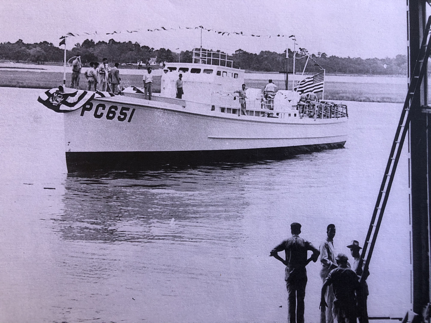
USS PC 651-was the second vessel completed by Westergard Biloxi Boat Works. She was launched 14 May 1942 only 2 weeks after her sister ship, USS PC 650, slid down the ways in Back Bay. The keel was laid 14 November 1941 for this 110-foot, wooden combat vessel. The crew consisted of three officers and 25 sailors. After commissioning in August 1942, PC 651 was given to the British Royal Navy and participated in D-Day, the Allied invasion of France in June 1944.
Barge Yard Land Acquisition-Leases
In order to procure the necessary acreage to build the US Army oil barges, the Biloxi Port Commission began acquiring leases west of the existing plant on Back Bay.
Dacey Lease
In February 1943, the Heirs-at-Law of Claudia G. Vick Dacey (1869-1937) and Marguerite Dacey (1900-1942), executed a one-year lease with an option to purchase to officials of the Westergard Boat Yard, William P. Kennedy II (1873-1951), Victor B. Pringle (1909-1977), Thomas N. Pringle (1906-1970), James W. Pringle (1914-1971) and W.B. Goodman, a co-partnership, on three tracts of land situated on Rhodes Point on the Back Bay of Biloxi. These three contiguous tracts which were bisected by Bayview Avenue ran north for over 800 feet to Back Bay and were for the part 185 feet in width. The lease ran from February 20, 1943 to February 20, 1944 and cost $1200 per year. If the option were executed during the lease period, the Dacey Heirs would sell their three parcels for $8000.(Harrison Co. Chancery Court Land Deed Bk. 255, p. 69)
Fountain Lease
In early March 1943, Frances Fountain Roberts, Ethel Fountain, Helen Fountain Fluker and Gussie E. Fountain Jr., the Heirs of Gussie Fountain Sr. entered into a lease agreement with the Westergard Boat Works. This lot had 62 feet on Back Bay and ran south 600 feet to Bayview Avenue. It was bounded on the east by the Braun Canning Company and the west by the Biloxi Port Commission and the People’s Bank of Biloxi. The rent was $400 for the first year with the lessee given a purchase option of $3600 after that had been concluded.(Harrison Co. Chancery Court Land Deed Bk. , p. 73)
People’s Bank of Biloxi Lease
The People’s Bank ease to Westergard Boat Works was very generous and extremely patriotic as it was a mere $20 per month. With 62 feet on Biloxi’s Back Bay and ran south across Bay View Avenue 450 feet to the property of Oris Danice. The Gussie Fountain Heirs were to the east and the Dacey Heirs to the west.(Harrison Co. Chancery Court Land Deed Bk. , p. 73)
Braun Lease
The Braun Canning Company entered into a lease with the Westergard Boat Works late March 1943. The rent was $500 each month until October 1943 when it decreased to $400 per month. The tract had 114 feet on Back Bay; east by City of Biloxi; south by Bay View Avenue; and west by the Heirs of Gussie Fountain.[Harrison Co. Chancery Court Land Deed Bk. p. 76]
The Braun Canning Company and shell crushing plant has been closed and the property leased to the Westergard Boat Works. The company moved to another location on Back Bay.[The Daily Herald, May 4, 1943, p. 2]
The Braun Canning Company and shell crushing plant has been closed and the property leased to the Westergard Boat Works. The company moved to another location on Back Bay.[The Daily Herald, May 4, 1943, p. 2]
Barge Launch
On June 18th, Westergard launched its 2nd, composite oil barge. The $2,000,000 contract called for the construction of thirty oil barges to haul petroleum products from Texas-Louisiana to Jacksonville, Florida via the Intracoastal Waterway. The hydrocarbons were off-loaded to other barges for shipment to cities on the Atlantic Seaboard. The barges were 160 feet long, 34 feet wide, and 10 1/2 feet deep with the capacity for 6000 barrels. James W. Pringle was superintendent of the boatyard and Connie Collins supervised construction.(The Daily Herald, June 19, 1943, p. 1)
Employee Housing
As Biloxi was witnessing exponential population growth at this time, public and residential housing was in demand. In late July, the Federal Housing Authority approved that 100 family dwellings be erected at Biloxi for civilian defense employees at Keesler Field and the Westergard Biloxi Boat Works. Bay View Homes, a Biloxi public housing complex, had 50-units allotted for Keesler laborers. As the airbase work declined, 40-units at Bay View Homes were to be occupied by Westergard employees. The new construction [sixplexes] was to be south of Harrison Court. I. Daniel Gehr, Biloxi architect, was involved in the project.[The Daily Herald, July 26, 1943, p. 1 and August 4, 1943, p. 1]
Barge Reduction
In early September, the management of the US Army Corp of Engineers at Philadelphia reassessed their oil barge construction progam and determined that they had overestimated the number of vessels needed. Their contract with Westergard Biloxi Boat Works was reduced. The Corps District office at Mobile related that this act was no reflection upon the quality of the watercraft that had been built by the Biloxi shipyard. Three oil barges under construction would terminate this program.[The Daily Herald, September 21, 1943, p. 2]
[TO BE CONTINUED]
[To Be Continued]
_____________________________________________________________________________________________
BOAT BUILDERS
North Biloxi [D'IBERVILLE]
MANUEL SANCHEZ
The Federal Census, Circuit Court and Chancery Court land deed records of Harrison County, Mississippi indicate that Manuel Sanchez (1806-1877), a Spanish immigrant, arrived in the United States circa 1823. He probably came through the port of New Orleans and married a Louisiana woman, Phillipine or Phillipa (1791-1879), before settling at Back Bay (D’Iberville), probably in 1833 or 1834. Manuel Sanchez was naturalized on March 4, 1846. It can be deduced from the deed records that he bought three arpents, fronting 576 feet, on the north shore of the Back Bay of Biloxi from Dominique Ladner prior to October 1834. (HARCO, Ms. Circuit Court Natutalization Bk. 1, p. 126)
Manuel Sanchez was a ship carpenter and probably was the first to operate a shipyard at what became known as Shipyard Point at Back Bay. Bill Holland’s unique wooden boatyard on Central Avenue in D’Iberville is at or near the same location today. The other Sanchez land on the Back Bay was the site of the former St. Theresa Catholic School, just east of Bill Holland and south of the old Catholic Church.
Manuel Sanchez built the first Catholic chapel at Back Bay during the War of the Rebellion (1861-1865). He erected a large wooden crucifix on the shoreline, which was later replaced with an iron cross, forged at Handsboro. It became a local legend that this cross was planted by Iberville (1671-1706), the French-Canadian soldier of fortune who landed on Biloxi Bay in February 1699. (Bremer, 1931)
The Sanchezs apparently had no children of their own, but appear to have left their land to Charles Manuel-Sanchez (1845-1897), a Black man who was probably their slave until Immancipation. Charles Sanchez sold a lot of land (89'x160') to Bishop Francis Janssen of the Diocese of Natchez in April 1884 (HARCO, Ms. Land Deed Book 20, pp. 88-89). This sale resulted in the construction of St. Theresa's Catholic Church (1884-1979).
Charles Sanchez appears to have reared Israel Sanchez, who he may have adopted emotionally, if not legally. When Charles Sanchez passed in July 1897, he legated his estate to Israel Sanchez. In his will, Charles Sanchez averred that he had "raised (Israel) from a child". (HARCO, Ms. Chancery Court Will Bk. 2, p. 43)
In March 1927, Mrs. Victoria R. Sanchez sold her ½ acre of land at Bayou Puerto situated in the NE/C of Lot 2, Section 13, T7S-R9W, to W.J. Engbarth (1887-1957) and H. Gladney (1900-1978). She was residing in Harrison County at the time of the conveyance. Mrs. Sanchez had moved to the Back Bay section of Biloxi about 1921, and found work in the seafood industry. She expired in July 1961, and her remains were interred in the Martin Ryan Memorial Cemetery on Bayou Puerto. (JXCO, Ms. Land Deed Bk. 60, p. 237 and The Daily Herald, July 24, 1961, p. 2)
_________________________________________________________________________________________________
JOSEPH SANTA CRUZ
JOHN SANTA CRUZ
JOHN FORETICH
ANTOINE FOUNTAIN
Antpoine Fountain(1848-1916) Ship carpenter in 1900. Son of Francois Fountain and Julienne Ladner. Married Willamine Young (1848-1910) in 1870.
CASMIR J. Harvey (1845-1904)
Casimir "Boy" Jacob Harvey Jr.
________________________________________________________________________________
MARTIN FOUNTAIN
Probably one of the most acclaimed boat builders of the Mississippi coast, Martin Fountain (1856-1938), got his start at Point St. Martin. He was born in the area, the last child of Francois Fountain (c.1798-c.1885) and Julienne Ladner (1815-c. 1876). In 1882, The Biloxi Herald of May 7, 1892, announced that, "Martin Fountain and S. Ladnier, of Jackson County, are building a fine shipyard for their own use, though outsiders can also be accommodated". Fountain built many Biloxi schooners. His home was located on what later became known as Birdsell's Hill, after Charles M. Birdsell.[The Biloxi Herald, May 7, 1892, p. 4]
Martin Fountain moved to Biloxi about 1903 and continued his shipbuilding skills there. Other boat builders of note in the area were Willie Fountain (1882-1963), J. Henry Cannette (1887-1969), who was known for his catboat construction, and Herman Kelly (1881-1948), who built shrimp trawlers on the Fountain Beach after WW II.
REFERENCES:
The Biloxi Herald, "Point St. Martin", May 7, 1892.
______________________________________________________________________________________________________________________
Casimir J. Harvey
Casimir Jacob Harvey (1845-1904) was the son of Pierre Harvey (1810-1893) and Zeline Moran (1811-1883). Both French appellations have been slightly anglicized-Harvey from Hervais or Herve and Moran from Morin. The 20th Century A.P. Moran (1897-1967) family of Ocean Springs can trace its roots here via Back Bay (D'Iberville) and Biloxi.
Casmir J. Harvey was reared at Back Bay on "Harvey Hill", an area north of present day Goodman Road. Several current "historians" obviously do not realize that this was the homestead of sailor, Pierre Harvey, not the Bayshore Drive location of his son, Casimir, which is often given in error.
Living at Back Bay in the mid-19th Century, were some of the pioneer shipwrights of the Mississippi coast: Dalmatian, John Baptiste Foretich (1813-1875), Spanish born, Nicholas Voivedich (1822-1896), and Spaniards, Manuel Sanchez (1806-1871), Bernard Taltavull (1829-1870+), and Jose Santa Cruz (1809-1886). Young Casimir chose marine carpentry as his trade and probably apprenticed himself to Senor Santa Cruz.
In October 1867, Casimir J. Harvey married Rosina Hosli (1852-1937), an 1856 immigrant from Canton Glarius, Switzerland. The Casimir J. Harvey home and shipyard were located on the waterfront of Back Bay, just west of the I-110 Bridge. Here the Harveys reared their family: Casimir J. Harvey, Jr. (1868-1957), Margaret H. Mulholland (1870-1900+), Maria R. Harvey (1873-1876), Caroline H. Saujon (1875-1918), Pauline H. Clifford (1878-1967), Claurine H. Holloway (1881-1940), Peter Harvey (1885-1904+), Emma Agnes Harvey (1889-1968), and Ida H. Santa Cruz (1892-1964).
Hurricane Camille (1969) destroyed the Harvey home, which was a one-story, wood frame Acadian cottage. Its three-bay front was capped by a hip roof. Casimir J. Harvey's granddaughter, H. Mercedes Holloway Guffey (1910-1998), resides today on the old home site at 3387 Bay Shore Drive, with her daughter, Joan Guffey. The second "post office" at Back Bay may have been located here as Casimir Harvey succeeded Annie Mallette Quave (1828-1904) as postmaster in April 1886.
Casimir J. Harvey operated his shipyard a few hundred feet west of his home. Casimir's skill as a boat builder was boldly exhibited in his "white winged queens", the Biloxi schooner. He and Casimir J. Harvey, Jr. built many of these sleek fishing vessels for the pioneer seafood operators of Biloxi. Among their schooners were: Emily Montross (1878), H.T. Howard (1889), Fairy Queen (1890), Emma Harvey (1891), Ida Mae Harvey, Carroll Clifford, Wyandotte, and White Wing (all 1904), Algonquin (1905), Tuscarora (1905), and Sioux (1906). The Emma Harvey and crew were lost in the July Storm of 1916, at Schooner Harbor in the Chandeleur Islands (see The Ocean Springs Record, The Emma Harvey: A Tale of the July Storm, July 7-July 21, 1994)
For nearly three decades, the Fairy Queen was a familiar sight to residents of coastal West Jackson County as it plied the waters of Fort Bayou and Back Bay. W.W. Branigar, brother of Harvey W. Branigar (1875-1953), a founder of Gulf Hills in 1926, organized the Fairy Queen Ship Company in 1927. It served that verdant resort as a pleasure craft to entertain guests. In March 1890, a reporter for The Biloxi Herald visiting Back Bay, related in that venerable journal:
Casmere Harvey's store is the first place that one strikes (when disembarking the ferry), and it is one that everybody can feel at home at. He carries a good stock of groceries and general merchandise as well as ship chandlery. Casmere has a tamed wild goose, and it is a beauty, for its kind. This web-footed customer follows Cass around like a dog, and when Cass is annoyed too much with its company he says: "Go home and don't make a goose of yourself". The goose goes.
With the shipyard busy and a prosperous retail store in operation, Casimir Harvey appears to have needed a place to relax and celebrate his success with his neighbors and in-laws. In December 1890, the Harrison County Board of Police granted him a license to retail vinous and spirituous liquors in quantities less than one gallon. The license was good for twelve months "in his barroom situated at the south end of Wells Road (now Boney Avenue) about where said road intersects the Back Bay of Biloxi".(Harrison County, Ms. Board of Police Minute Book 4, p. 80)
Casimir J. Harvey and his young brother, Philip Harvey (1851-1918), were involved in local horse racing and trading. Phil Harvey especially developed a reputation as a knowledgeable horseman at Back Bay and Point St. Martin where he later resided and operated a store.
There appears to have been two excellent horseracing tracks in the North Bay area at the turn of the Century. Present day Race Track Road owes its descriptive appellation to the "Sport of Kings". Several reports in The Biloxi Herald of March 1890, related the Harvey brothers involvement in this activity: Casmere Harvey is proud in the possession of one of the fleetest horses on the coast, and Clara P., for symmetry and beauty of proportion in limb and length is hard to beat. Casmere Harvey has sold his celebrated racer "Cannon Ball". In horse trading, Mr. Phillip Harvey has no rival. No equine beauty passes his critical eye without a bid; and he invariably, like the notorious Eli, gets there. Phil Harvey had a good trip of over thirty-five miles in the country in the early part of the week after a runaway horse. He got his strayed animal and did some profitable horse trading at the same time. Nothing slow about Phil.
The Emma Harvey
According to the indigenous people of coastal Mobile County, Alabama, the high tides and strong winds of Hurricane Frederick on September 12, 1979, blew this Casmir Harvey built schooner into the wide expanses of the Mon Island Marsh or Portersville Bay to the west of Cedar Point. The fate or position of the Emma Harvey is presently unknown, but it is generally held that the Biloxi built schooner was destroyed by Hurricane Frederick.
"EMMA HARVEY": A TALE OF THE JULY STORM, 1916
The recent near miss of Tropical Storm Alberto on July 3, 1994 reminded me of an incident that happened on the Mississippi Coast seventy-eight years ago almost to the day. It is a true story well documented in the journals and lives of the people of that time.
Ocean Springs
In the humid morning of July 6, 1916, railroad agent, John Drysdale (1869-1934), walked slowly across the L&N Railroad Bridge from Ocean Springs towards Biloxi. Soon he would announce to the world the fate of his little town on the eastern shore of the Bay of Biloxi. During the early morning hours a hurricane struck the Mississippi Coast roaring through Ocean Springs with wind gusts up to 125 mph. Destruction wrought by the tempest was manifested in roof, fence, chimney, tree, and shed damage.
No one was seriously injured, but plumber, George Dale (1872-1953), got a good scare when the Knights of Pythias Hall, which he was occupying during the storm got blown off its foundation. The colored Baptist Church was heavily hit by the strong wind force, and had to be demolished in the days following the storm. In the country, the Rose Farm north of Fort Bayou reported severe damage. At the C.E. Pabst (1851-1920) pecan orchards some of the older trees were damaged. More fortunate was Theo Bechtel (1863-1931) reporting only slight ruin to his potential crop.
Biloxi
At Biloxi, L&N Agent Drysdale found that city in great suffering. The hurricane had struck there also with unrelenting fury. The Back Bay and Point Cadet areas were especially hit hard. It would be days and even weeks before all the news of the great natural disaster would be known. At the time many ships were operating in the Mississippi Sound. These vessels weren't outfitted with the communication and weather reporting devices we have today. Consequently, most of the sailors and their vessels were caught unprepared. Many of the Biloxi schooners were fortunate in that they were working near the partially sheltered Louisiana marshes. Other mariners sought haven in the lee of the offshore barrier islands. Those not so fortunate rode the storm out at sea. Most seamen made it home to their port. One small Biloxi schooner wasn't so fortunate. It was the Emma Harvey and her story follows.
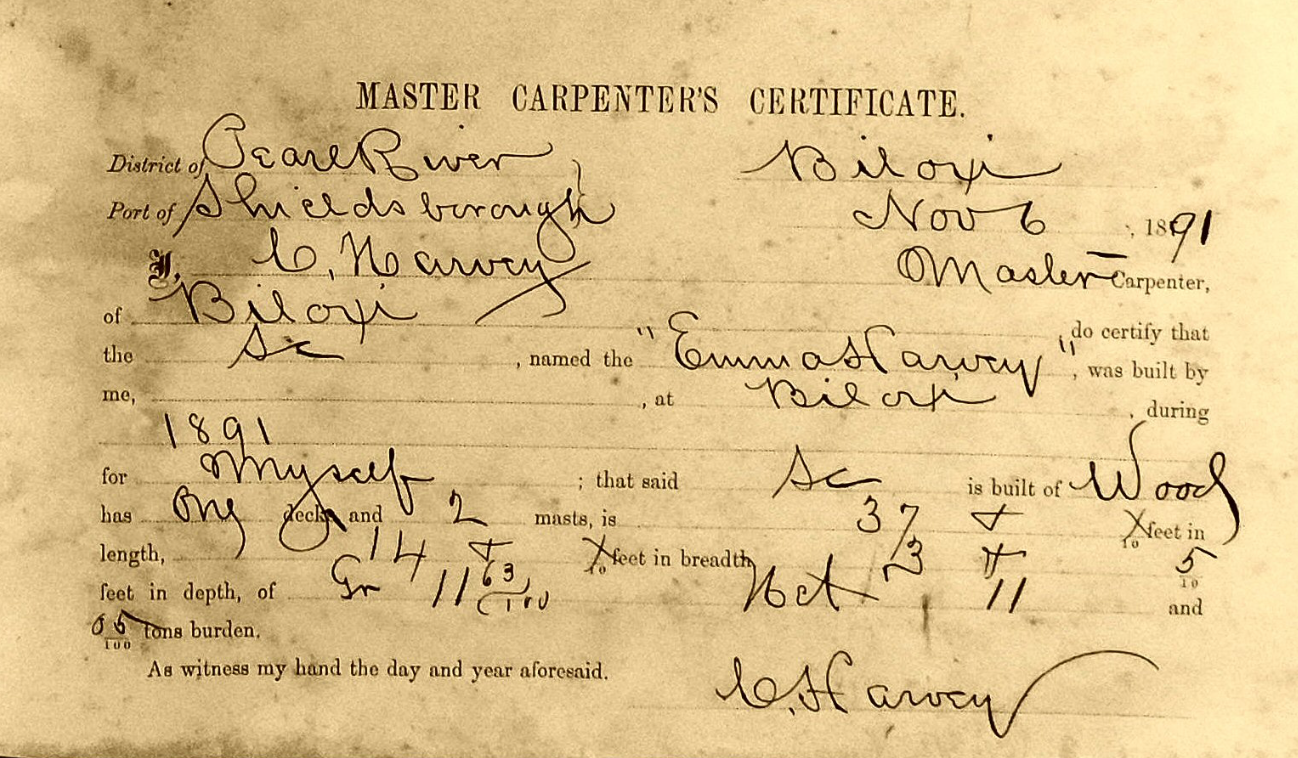
[courtesy of Russell Barnes-September 2020]
The Emma Harvey
The Emma Harvey was a Biloxi schooner utilized in the tourist, shrimp and oyster industry of the Mississippi and Louisiana marshes in the early years of the 20th century. She was built by Casimir J. Harvey (1845-1904) at his Back Bay, now D'Iberville, shipyard probably in 1891, and was named for his youngest daughter, Emma Agnes Harvey (1889-1968). The physical dimensions of the Emma Harvey as reported on its Master Carpenter's Certificate of Novemebr 1891 are as follows: length=37 feet, beam= 14 feet; and hole depth 6 feet.
It is also documented that Casimir Harvey conveyed a schooner on May 25, 1889, to H.T. Howard. The boat was called the H.T. Howard, and was thirty six feet in length, fourteen and two sixteenth feet in breadth, three feet deep, and weighed eight and thirteen one hundredths tons. From Biloxi regatta entries, the Emma Harvey competed as a schooner in the under 40-foot class.[Chancery Court, Harrison Co., Mississippi Chattel Book 2, p. 232 and The Biloxi Daily Herald, August 19, 1900, p. 8]
The Emma Harvey participated in some of the early Biloxi schooner races. In the 1901 Biloxi Regatta, she withdrew before finishing the first round because of heavy seas. After the days of the White Winged Queens had passed, the Emma Harvey was converted to a charter boat and trawler. She was last seen about 1978 in a canal at Cedar Point, Alabama north of Dauphin Island. Every ship has a tale to tell. The Emma Harvey has many and is an unusual craft as will be demonstrated.[The Biloxi Daily Herald, July 7, 1901, p. 1]
On Tuesday morning, the Fourth of July 1916, the Emma Harvey owned by Ulysses (Lel) Desporte (1861-1927), a Biloxi, commercial, oyster dealer, departed Back Bay on a shrimping trip to Chandeleur Island. Unknown to Captain George Duggan and his crew who consisted of Arthur Duggan, Lawrence Bennett, John Helm [1893-1916], John McDuffy, and Jack Atkinson, an Englishman, a category three hurricane was poised to strike the Mississippi Gulf Coast the following afternoon (July 5th).
The July Storm
The July Storm as it is known in the annals of Gulf Coast meteorology came ashore between Ocean Springs and Pascagoula, Mississippi. During this tropical cyclone, several barometers in Biloxi registered 28.08" of mercury. Although this was the lowest barometric pressure ever recorded to this date, it was relatively high when compared to the tornado-like Camille of August 1969, which had a record low pressure for any storm to that time of 26.58" of mercury. Hurricane Wilma [2005] is now the record holder with a pressure of 26.05” of mercury.
In the early hours of the tempest, the wind direction of the July Storm was northeast, but shifted to the west where it remained until it abated in the early hours of the morning of July 6. A wind velocity of 90 miles/hour was recorded at Biloxi.
The Emma Harvey reached Chandeleur Island and was at anchor in Schooner Harbor on the west side of the island. This fact was corroborated by Captain Robert Williams of the schooner, Lagoda, also a victim of the furious storm. Other ships in the immediate area were the schooners: Laguna (Lagonia), and the Beulah D. The crews of these vessels were rescued in the days immediately following the hurricane by boats from Biloxi.
A vivid description of the harrowing experience in the Chandeleurs aboard the Beulah D is given by Louis Largilliere (1861-1950) in the July 10th, 1916, The Daily Herald (pp. 1 and 3).
He stated that: he never wanted to go through such an experience again and he is grateful that he reached the mainland again. The Beulah D was caught in the storm while at anchor in Chandeleur Sound near North Keys. After the blow had overtaken them they put out two anchors but they were of no avail and the schooner was carried about the Gulf for a distance of thirty five miles after the masts had both blown out by the gale. During the drifting of the boat the members aboard were compelled to remain below most of the time as the wind was so strong that had they attempted to walk on deck they would have been blown overboard and lost forever. The hatches of the boat were blown away and canvas had to be tacked down to keep out the torrents of rain.
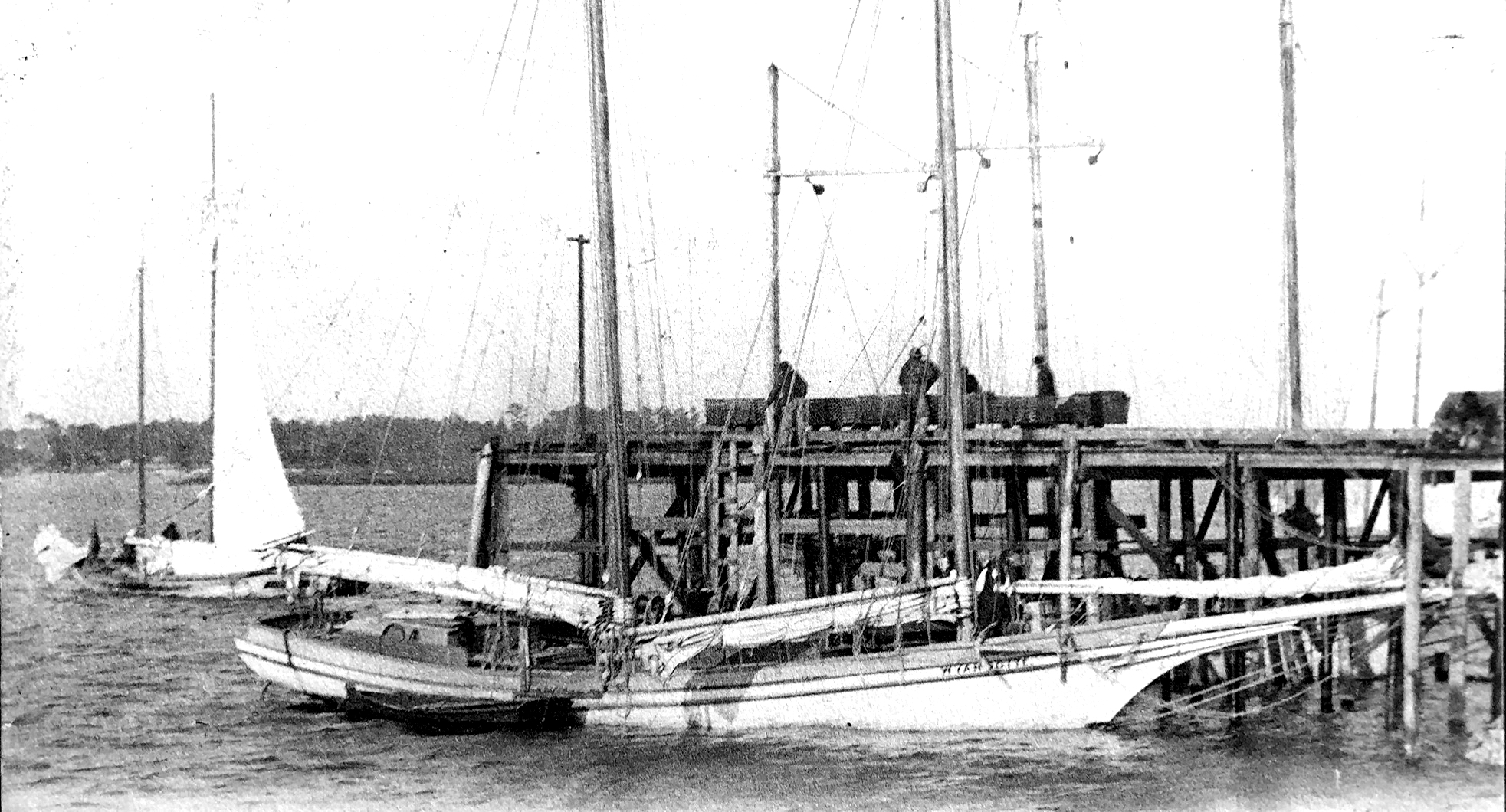
Wyandotte-Another Casimer Harvey [1845-1904] built schooner depicted in this vintage postcard was the Wyandotte. The Wyandotte was constructed in 1904 for William F. Gorenflo [1844-1932], pioneer Biloxi seafood magnate and philanthropist. The Gorenflo factory was situated on Back Bay near Main Street. Like the Emma Harvey, the Wyandotte, was a victim of the 1916 July Storm. She was capsized and beat to pieces in Back Bay.[The Biloxi Daily Herald, January 27, 1904, p. 6 and The Daily Herald, July 7, 1916, p. 7]
Search
In the days and weeks following the great blow, Lel Desporte sent out motor vessels, primarily the Ursula C, captained by Johnny Duggan or Boy Bennett. With other relatives of the missing crew, they made a complete search of Cat Island, the Chandeleurs, Cryhoe Bay, Point Comfort, Earl Island, Bird Island, Breton Island, Taylor's Pass, North Keys, Battle Door, Southwest keys, and Neptune, Louisiana. This valiant search of the western sector discovered the abandoned schooner, Segura, and the schooner barge, Hussler, both from Biloxi at Cryhoe Bay in the Louisiana marshes. At Taylor's Pass, they located a drowned fisherman.
The only physical sign of the Emma Harvey after the great storm in the Chandeleurs was reported by Captain G.L. Fields of the schooner, Beulah D, who stated that when his crew went ashore on the island to search for signs of the Emma Harvey, they found nothing but a small meat board and small pieces of rope that had drifted ashore from some boat during the gale. They could see in the sand where the Emma Harvey was believed to have dragged her two anchors in her journey across the island to the east during the blow.
By late July, the hunt for the missing schooner continued aboard the Ursula C now captained by Floyd Lanius [1886-1936]. Henry and Fred Duggan, son of Captain George Duggan, were also aboard. The search party now concentrated its relentless efforts to the east combing Horn, Petit Bois, Dauphin, and lesser islands in that area. They also went to Pascagoula, Mobile, and the west Florida coast seeking information and leads. There were some sightings in the eastern Gulf, which gave hope for locating the missing crew and boat. The Coast Guard cutter, Tallapoosa, reported on July 11 that it had passed a schooner's mast twelve feet out of the water at Latitude 29.18 N and Longitude 86.55 W (approximately 100 miles southeast of Pensacola). About the same time, the private yacht, Shirin, of New Orleans passed a vessel within six miles of Grant's Pass (near Dauphin Island) with its right side up.
An unusual event occurred on August 2, when Martin Lomax, a teenage lad from Biloxi, found a bottle with a note in it on the south side of Deer Island. The note read: "Help. Help. On an unknown island". Signed George Duggan and crew. Some thought the note a hoax while others believed John Helm had written it since he always carried an empty flask in his pocket when at sea to be prepared for the emergency of a shipwreck.
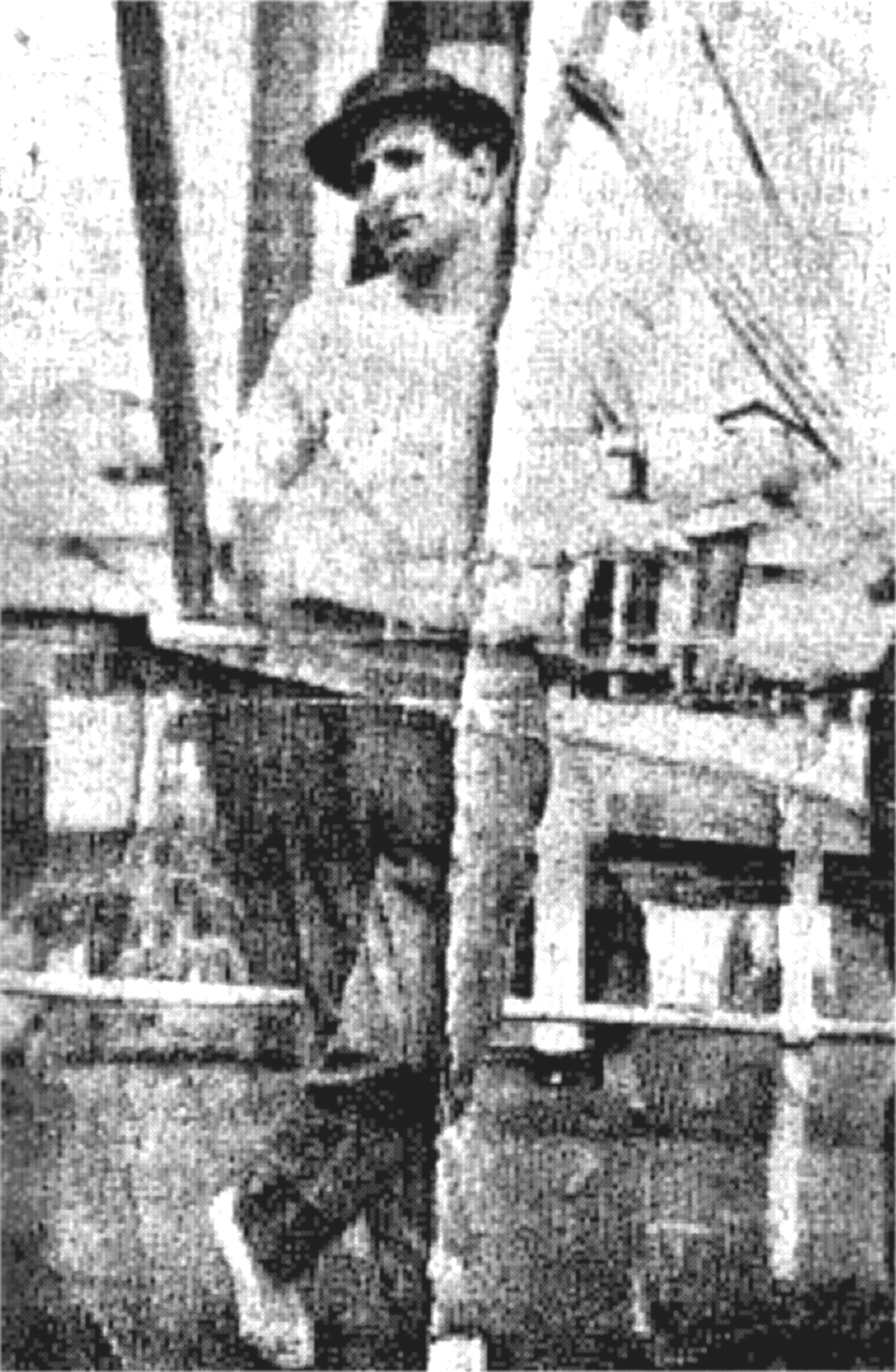
John Henry Helm [1893-1916]
John Henry Helm [1893-1916]-Young Helm was a crewman on the ill-fated Emma Harvey on that July 5th day of 1916. He was a NOLA native of German ancestry. John Helm had the reputation of carrying a vial or bottle to sea. He envisioned that in an emergency situation, a message could be written, placed in the sealed vial and thrown overboard to be carried by winds and tides hopefully to be discovered someday revealing his fate. In August 1916, the overturned hull of the ravaged Emma Harvey was found south of Santa Rosa Island near Pensacola, Florida. Helm’s remains of those of his shipmates have never been located.
Found
The destiny of the vanished Emma Harvey was revealed to the world on August 12, when the lost schooner was located by two fishing boats from Pensacola. She was found floating bottom side up about twenty-five miles from Pensacola (other reports point to a location of seventy five miles). No sign of Captain Duggan or any members of his crew were ever found. The derelict vessel was towed to a mooring point near the Perdido Wharf in Pensacola by the tug, William Flanders.
Mr. Bruce S. Weeks, Deputy Collector of Customs at Pensacola, stated in his report of the incident the following: There are absolutely no indications that the crew of the Emma Harvey was saved and he expressed the opinion that the men from Biloxi, who went to the Chandeleur Islands on July 5, were lost in the hurricane, which swept over the Gulf on that date. No indication of crew and there does not seem to be much probability that they ever got away in the boats. The crew evidently cut away the rigging on the starboard side, but failed to cut it on the lee side first, and apparently, the rigging went over the port side, hung and the vessel simply turned over. The anchors appear to have been out, but only a short length of chain.
The Biloxi schooner, Emma Harvey, was deemed worth saving by Captain Rocheblane of the towing vessel, William Flanders, but because of the great salvage and towing expense, Lel Desporte decided to dispose of her in Pensacola.
The precedent information was assimilated from The Daily Herald in the issues July 7, 1916 through August 29, 1916.
Frank J. Duggan
A personal perspective of the incident is given by Frank J. Duggan (1912-2000) who is the sole surviving son of the skipper of the Emma Harvey, George Duggan. Frank Duggan resides at 344 Fayard Street in Biloxi on the site that his family moved to circa 1905. Previously the Duggans lived at 747 Reynoir. As Frank Duggan was only four years of age when his father, George, brother, Arthur, and cousin, Lawrence Bennett drowned that stormy July 5th evening east of the Chandeleurs, it wasn't until years later at the dinner table or while drinking beer with his older brothers, Charlie and Fred Duggan, that he would hear the familial version of the Emma Harvey disaster. The following narrative is a summary of the tale of the Emma Harvey as told to me by Frank J. Duggan on December 17, 1990.
The voyage to Chandeleur commenced as a suggestion from Johhny McDuffy when he told George Duggan, "hey, Cap, they're slaughtering shrimp out there and getting redfish with them in the seine". Captain Duggan mustered his crew, but son, Fred had disappeared to parts unknown. When the anchor was weighed, Fred Duggan was replaced by his brother, Arthur, a newly wed. Arthur was eager to earn good wages for his new family situation. Fred Duggan who had sailed on the Emma Harvey many times with his father never liked the little vessel, and thought it unsafe in rough weather. He referred to it as a "deathtrap" and admonished Charlie Duggan to never sail on her. Fred preferred the larger schooner, Cavalier, and could never understand his dad's love for the smaller boat. The tragedy of the July Storm of 1916 has remained with the Duggan Family through the years as one would expect from such a sudden loss of loved ones.
After the Emma Harvey was towed into Pensacola and salvaged, a Miami man bought it from salvagers. He had it towed to southern Florida, and refurbished it with a new cabin, engine, and trawls. The US Coast Guard became suspicious of the vessel since it never seemed to utilize it fishing gear. When they boarded the craft, a cargo of illicit Cuban spirits was discovered in the hole. The rum runner was confiscated and sold at a sealed bid auction in Miami as a victim of the Prohibition enforcement years (1919-1933). The purchaser, an Alabama man, returned the Emma Harvey to the Gulf Coast, probably to Bon Secour, Alabama.
Cedar Point, Alabama
A trip by the author, to Cedar Point and Dauphin Island, Alabama on December 31, 1990 resulted in telephone conservations with Sadie Mae Collier Serra and John Henry Lamey. Sadie Serra is the daughter of Frank Collier. According to her, Frank Collier obtained the Emma Harvey from a Bon Secour man in a trade. The man may have been John Steiner or Budgey Plash. Collier gave $800 worth of fine oysters for the vessel. Mrs. Serra, the tenth of eleven Collier children, told of her father's success as a business man in Mobile County. Frank Collier and two associates owned twenty-five boats, a canning factory and grocery store on Dauphin Island, and an ice plant at Mobile. A disastrous fire at the ice plant and the Great Depression combined to bring the Colliers to financial chaos. They moved to Cedar Point circa 1933 with only 75 cents in the family treasury. Frank Collier began life anew by oystering in the bay. His wife opened the mollusks and sold them. This "mom and pop" operation slowly grew, and the Collier children were integrated into the operation as their age allowed. Sadie Mae Serra said that the Collier fortunes improved rapidly after the Emma Harvey acquisition.
Initially, the old Biloxi schooner was put to work as a ferryboat transporting people, mail, automobiles, and cattle from Cedar Point to the island. The Colliers ran a herd on the west end of Dauphin Island. Prior to World War II, the Emma Harvey would take day charters to the snapper banks. During the war years, fear of German submarines caused Captain Collier to ply the coastal and bay waters for trout. He would take as many as twenty people out for $30 per day and give them a delicious fish fry after the trip.
During the September 1947 Hurricane, the Emma Harvey was trapped by low tide at her mooring in the Cedar Point canal. The Collier family left for higher ground. When they returned the next morning, they found the valiant little lady on high ground adjacent to their store. During the night of fierce winds and violent seas, the vessel had stood as a barrier to protect the Colliers' building from storm tossed flotsam and other debris.
John Henry Lamey, a neighbor to Sadie Mae Serra, at Alabama Port worked as a deckhand on the Emma Harvey in the 1940s and 1950s with Weldon "Doc" Collier, the brother of Sadie Serra. He vividly recalls the search and discovery of the wreckage of a National Airlines DC-6 airliner, which crashed into the Gulf about twelve miles south of Fort Morgan. The accident occurred in February 1953. The commercial aircraft was en route to Moissant Airport, now Louis Armstrong International, at New Orleans from Tampa when it went down as the result of turbulent weather.
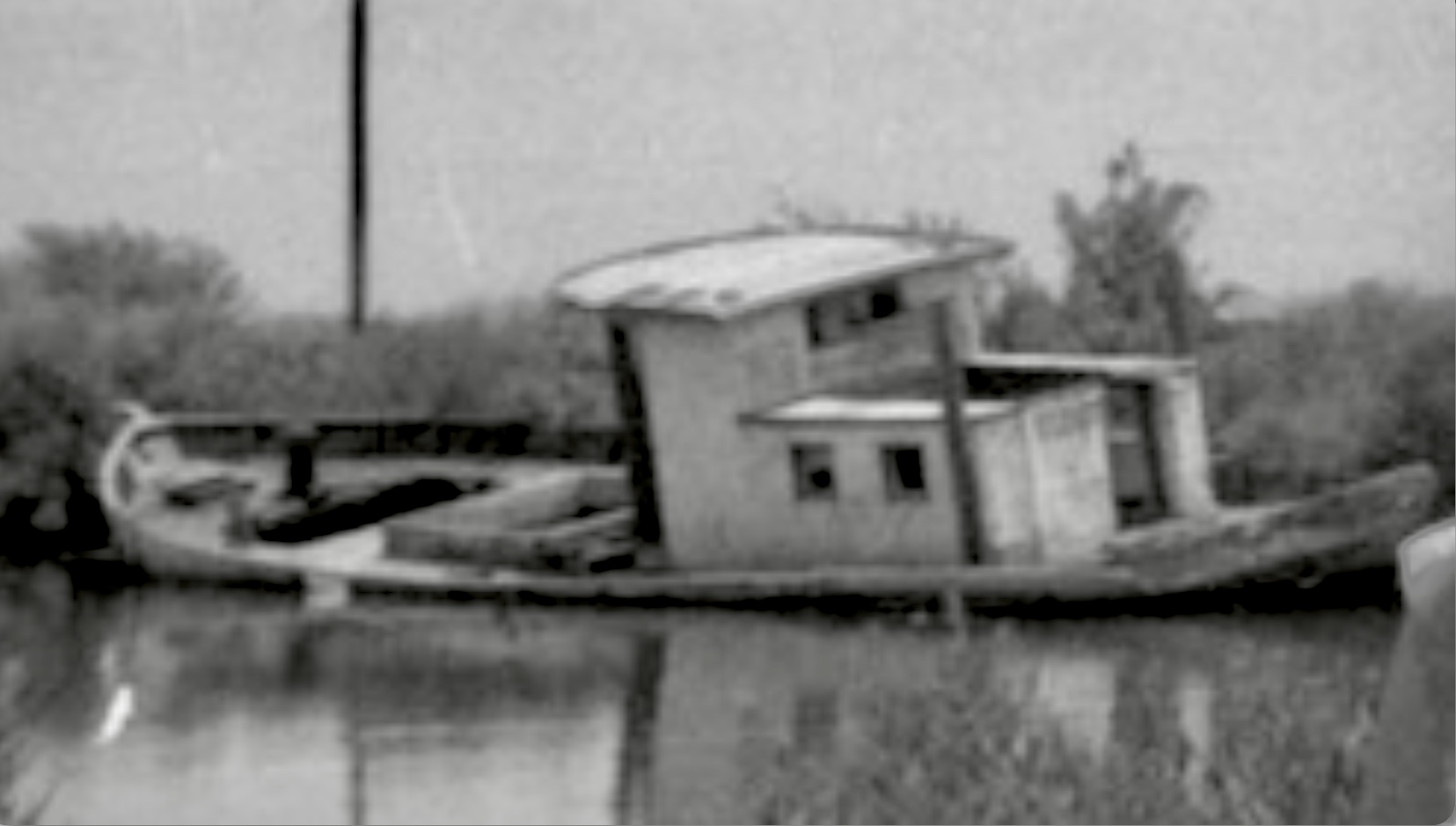
Emma Harvey [July 1971]
In July 1971, Lottie Duggan Foretich [1905-1994] visited this canal site at Cedar Point, Alabama, where the schooner Emma Harvey was moored. Her father, George Duggan, and brother, Arthur Duggan, died in the 1916 July Storm and their corporal remains were never found. According to the indigenous people of coastal Alabama, the high tides and strong winds of Hurricane Frederick on September 12, 1979, blew the Casimir Harvey built schooner into the wide expanses of the MonIsland marsh or Portersville Bay to the west of Cedar Point. The fate or position of the Emma Harvey is presently unknown, but it is generally held that the Back Bay, Biloxi built schooner was destroyed by Hurricane Frederick.[image from H. John Gutierrez <myfamilyinfo.info>]
After the Dauphin Island Causeway was completed in the 1950s, the Emma Harvey plied the bay and Gulf waters as a shrimp trawler. According to the indigenous people of coastal Alabama, the high tides and strong winds of Hurricane Frederick on September 12, 1979, blew the Casmir Harvey built schooner into the wide expanses of the Mon Island marsh or Portersville Bay to the west of cedar Point. The fate or position of the Emma Harvey is presently unknown, but it is generally held that the Biloxi built schooner was destroyed by Hurricane Frederick.
Cedar Point, Alabama
A trip by the author, to Cedar Point and Dauphin Island, Alabama on December 31, 1990 resulted in telephone conservations with Sadie Mae Collier Serra and John Henry Lamey. Sadie Serra is the daughter of Frank Collier. According to her, Frank Collier obtained the Emma Harvey from a Bon Secour, Alabama man in a trade. The man may have been John Steiner or Budgey Plash. Collier gave $800 worth of fine oysters for the vessel. Mrs. Serra, the tenth of eleven Collier children, told of her father's success as a business man in Mobile County. Frank Collier and two associates owned twenty-five boats, a canning factory and grocery store on Dauphin Island, and an ice plant at Mobile. A disastrous fire at the ice plant and the Great Depression combined to bring the Colliers to financial chaos. They moved to Cedar Point circa 1933 with only 75 cents in the family treasury. Frank Collier began life anew by oystering in the bay. His wife opened the mollusks and sold them. This "mom and pop" operation slowly grew, and the Collier children were integrated into the operation as their age allowed. Sadie Mae Serra said that the Collier fortunes improved rapidly after the Emma Harvey acquisition.
Initially, the old Biloxi schooner was put to work as a ferryboat transporting people, mail, automobiles, and cattle from Cedar Point to the island. The Colliers ran a herd on the west end of Dauphin Island. Prior to World War II, the Emma Harvey would take day charters to the snapper banks. During the war years, fear of German submarines caused Captain Collier to ply the coastal and bay waters for trout. He would take as many as twenty people out for $30 per day and give them a delicious fish fry after the trip.
During the September 1947 Hurricane, the Emma Harvey was trapped by low tide at her mooring in the Cedar Point canal. The Collier family left for higher ground. When they returned the next morning, they found the valiant little lady on high ground adjacent to their store. During the night of fierce winds and violent seas, the vessel had stood as a barrier to protect the Colliers' building from storm tossed flotsam and other debris.
John Henry Lamey, a neighbor to Sadie Mae Serra, at Alabama Port worked as a deckhand on the Emma Harvey in the 1940s and 1950s with Weldon "Doc" Collier, the brother of Sadie Serra. He vividly recalls the search and discovery of the wreckage of a National Airlines DC-6 airliner, which crashed into the Gulf about twelve miles south of Fort Morgan. The accident occurred in February 1953. The commercial aircraft was en route to Moissant Airport, now Louis Armstrong International, at New Orleans from Tampa when it went down as the result of turbulent weather.
After the Dauphin Island Causeway was completed in the 1950s, the Emma Harvey plied the bay and Gulf waters as a shrimp trawler. According to the indigenous people of coastal Alabama, the high tides and strong winds of Hurricane Frederick on September 12, 1979, blew the Casmir Harvey built schooner into the wide expanses of the Mon Island marsh or Portersville Bay to the west of cedar Point. The fate or position of the Emma Harvey is presently unknown, but it is generally held that the Biloxi built schooner was destroyed by Hurricane Frederick.
Pierre Hervai
Pierre Harvey (1810-1893) was born in France about 1810. He is the patriarch of the Harvey family of the Mississippi Gulf Coast. It is not known precisely when Pierre Harvey came to the United States or from which French city or department that he immigrated. It is very likely that he arrived in the Back Bay (North Biloxi) community in the 1830s. Here, the young French seaman met and married Celina Morin (1811-1883) on February 20, 1840. The name Morin is now spelled Moran. The marriage of Pierre Harvey and Celina Moran was recorded in the Book of Marriages, Volume 8 (1840-1842), Folio 103 of the Archives of the St. Louis Cathedral at New Orleans.
Pierre Harvey and spouse had settled on the 46 acres in Section 17, T7S-R9W he had acquired from his father-in-law, Joseph Moran II, in 1842. He sold 37 acres to J.L. Lastinger reserving 9-acres which was probably the Harvey homestead. As one can see from the topographic map of the area, it was well named as it was called "Harvey Hill". The City of D’Iberville recently placed a historical marker for “Harvey Hill”.
On March 2, 1846, Monsieur Harvai made the following statement in the Circuit Court of Harrison County: This day being a day of the term of said court the second day of March A.D. 1846 personally came and appeared in open court, Pier (sic ), who being duly sworn, and solemnly acclaim that it was his bonafied intention to become a citizen of the United States of America and to renounce forever all allegiance to any foreign state, prince, or sovereignty whatsoever and particularly to Louis Phillip King of the French he has heretofore been a subject.(Minutes of the HARCO, Ms. Circuit Court-Book 1, p. 116)
Pierre Harvey became a citizen of the United States of America on March 6, 1848. This act took place at the Harrison County Circuit Court at Mississippi City and was recorded in the Minutes of the HARCO, Ms. Circuit Court-Book 1, page 183.
Pierre and Celina Harvey lived on the Back Bay of Biloxi near her father, Joseph Moran II. Here he made his livelihood as a seaman and fisherman. Harvey probably toiled in the coastal schooner trade. Naval stores, salt, lumber and charcoal were produced locally and shipped to New Orleans and Mobile. The traders returned with food staples, tools, and cloth.
The Morin (Moran) Family of the Mississippi Coast originated at St. Pierre-du-Sud, Quebec, Canada. Here Joseph Morin, was born of Denis Morin and Madeleine Boulet. He settled at Cat Island and married Louise Ladner, the daughter of Nicolas Ladner and Marie Anne Pacquet, in 1778. All of their children were born and reared at Cat Island.
Pierre Harvey died on September 30, 1893. Celina Moran Harvey preceded him in death. She expired on September 21, 1883. Their remains were probably interred in the Moran Cemetery at D’Iberville, Mississippi.
To my present knowledge, Ocean Springs and Jackson County residents with direct familial connections to the Emma Harvey through its builder, Casimir J. Harvey (1845-1904), are: former Ward IV Alderman, Philip ‘Phil’ I. Harvey [1941-2012] and family; Carroll L. Clifford Jr. [1925-2006], former Jackson County Board of Supervisor from Gautier, and family; and myself.
Epilogue-Ocean Springs, Mississippi-July 7, 1994
Today I receive a telephone call from Bobbie Bond Helm who resides at 309 Live Oak in Ocean Springs. She tells me that her husband, Joseph O. Helm, Jr., is the nephew of John Henry Helm (1893-1916) who was a crew member of the Emma Harvey. Mrs. Helm further details the Helm Family relating that there were four Helm brothers and a sister: Conrad (1890-1914), Martin (1891-1954), John Henry (1893-1916), Joseph O. (1896-1968), and Rita (1898). Their father, John G. Helm (1867-1949), of German ancestry was born at New Orleans while their mother was Josephine Molero (1858-1914) of St. Bernard, Parish. The Moleros were from the Canary Islands. All the Helm men were born at New Orleans, and died at Biloxi, except John who was lost at sea east of the Chandeleurs on July 5, 1916.
Frank J. Duggan (1912-2000), the son of Captain George Duggan, the skipper of the ill-fated, Emma Harvey, resided at Biloxi and was married to Carrie Mae Voivedich (1913-2001). She spent her formative years at Ocean Springs. Mrs. Duggan's father, Nichcolas Voivedich, owned a store, on Washington Avenue about where Miner's Toys is now located. The Voivedich Brothers store closed in the mid-1920s.
Familial connections to the Emma Harvey through its builder, Casmir J. Harvey (1845-1904), are: former Ward IV Alderman, Phil Harvey; Carroll Clifford, Jackson County Board of Supervisor from Gautier; and myself. Phil Harvey is as direct descendant of Pierre Harvey, Jr. (1841-1878) and Victoria Koehl (1850-1904). Mr. Clifford descends from the builder, Casmir Harvey and Rosina Husley (1852-1937), and I am a descendant of Marie Harvey (1840-1894), and Antoine Victor Bellande (1829-1918). Marie was the eldest child, of French immigrant, Pierre Harvey (probably Hervais or Herve) (1810-1880+), and Celestine Moran (1811-1883). Casmir, Pierre, Jr., and Marie Harvey, who were born at Back Bay (present day D'Iberville), were siblings.
_________________________________________________________________________________________________________________
WILLIE FOUNTAIN (1882-1963)
Died June 25, 1963. Married Tamelia Fossier (1879-1963). Located at Harrison County, north of Fountain Cemetery.
REFERENCES:
Viola Moore Cannette-August 1996.
______________________________________________________________
J. HENRY CANNETTE (1887-1969)
Built catboats on west side of Avery Point.
____________________________________________________________
HERMAN KELLY (1890-1948)
Built boats on Fountain beach after WW II.
__________________________________________________________________
WILLIAM T. HOLLAND (1943-2005+)
Boat yard located on the historic site of Manuel Sanchez and John Foretich at 9362 Central Avenue. Graduate of Biloxi High School?
REFERENCE:
The Biloxi-D'Iberville Press, "A part of South Mississippi's History", October 4, 1995, p. 13.
______________________________________________________________________________________________________________________________________
FRANCIS A. TALTAVULL
FRANCIS A. TALTAVULL (1851-1930) married Mary Margaret Bertheaud (1860-1904) on March 19, 1879. She was the daughter of Benjamin Bertheaud (d. pre 1866) and Anna Marie Abbley (1842-1917). The Bertheauds were married by Justice of the Peace, Berry Wells (1812-1876), on October 23, 1858, in Harrison County. Their other children were Rosalie Bertheaud (b.1862), and Mary Victorine Bertheaud (b. 1865). After the death of Benjamin Bertheaud, Anna Marie married Joseph Santa Cruz (1809-1886) on July 10, 1866. Anecdotal history relates that there were eight children born to this union, but only four sons survived: Fritz Santa Cruz (1870-1952), Rudolph Santa Cruz (1872-1932), Adolph Santa Cruz (1881-1972), and Randolph Santa Cruz (1882-1971). Joseph Santa Cruz was born at Palma on the island of Majorca.
In 1880, Francis and Margaret Taltavull were residing at Back Bay (now D'Iberville) next to her mother, Mrs. Joseph Santa Cruz. Both men are ship carpenters. The children of Francis A. Taltavull and Marie Marguerite Bertheaud were: Mary “Maggie” T. Moran (1880-1948), wife of W.E. Moran; William Bernard Taltavull (1882-1948), Francis A. Taltavull (1883-1950), Alphonsine Taltavull (1885-1885?), and Margaret T. Venus (1888-1966), wife of Joseph Venus.
Frank Taltavull learned the Spanish language and the art of shipbuilding from his father, Bernard, on the shores of North Biloxi. His father took him to Cuba during the Civil War and he later worked for the Brooklyn Boat Works at New York City where he learned large shipbuilding methods.
In March 1880, Frank Taltavull bought a tract of land in a State tax sale for $3.20. It was formerly owned by William Sylvester. The land was located on the north shore of Back Bay and had one arpent (192 feet) on the water and was one mile deep. Pierre Quave was to the east and Joseph Moran to the west. There is a high degree of certitude that Taltavull located a shipyard here. This is corroborated by The Biloxi Herald of March 19, 1892. The journal announced that the new schooner, Emma R. Clemens, owned by John Moran was launched from Frank Taltavull's shipyard. Home belles who attended the ceremony were: Laura Quave, Coline Harvey, Virginia and Theresa Moran, Edna Studebaker, Lena and Josephine Newman, and Melissa and Viola Seymour.(Harrison County, Ms. Land Deed Book 17, p. 370)
Frank Taltavull advertised his business in The Biloxi Herald of October 5, 1893 as follows:
BACK BAY SHIP YARD
F. Taltavull practical Ship Carpenter and Boat Builder
Vessels built, hauled out and repaired on short notice and at reasonable prices. The yard is supplied with all the modern appliances necessary to do first class work, and vessels also hauled out by steam.(p. 4, c. 3)
The October 1893 Hurricane washed away Taltavull's shipyard on Back Bay. Probably as a result of losing his business and to locate closer to the seafood canneries on the south shore of Back Bay, Frank Taltavull moved to Biloxi in 1894, and resided on
Reynoir Street By 1895, he was operating a shipyard on Back Bay. Mr. Taltavull was known for constructing fast sailboats, schooners, steam launches, and tugs.
In May 1894, the new, 18-foot catboat, Rosina, built by Mr. Taltavull was for sale by Wallace Montross of the Montross Hotel. Asking price $65.(The Biloxi Herald, May 26, 1894, p. 8)
Two Frank Taltavull built vessels, the schooner, A. Gerdes and Brother, and the steam tug, Julius Elbert, became involved on May 29, 1901. Captain Antoine V. Bellande (1829-1918) was in command of the schooner in the Mississippi Sound en route to Ocean Springs. The seven-man crew was below preparing for bed with a green sailor at the helm. The weather roughened and his inexperienced allowed the vessel to capsize. Captain Bellande and his crew were found by the Julius Elbert clinging to their stricken ship. They were rescued and having lost all their possession to the sea.(The Biloxi Daily Herald, May 29, 1901)
In 1905, the Taltavull & Rerecich Shipyard is in operation at 402 East Back Bay Avenue. It was sold by Bernard Taltavull to George Melvin in August 1908. Casimero Rerecish (1858-1918) was an 1896 Austrian (probably Croatian) immigrant.(HARCO, Ms. Chattel Bk. 10, p. 216.)
Frank Taltavull was beset with eye disease in his old age. Described as “paralysis of the eye”, he visited an eye specialist at New Orleans in March 1928 with some relief.(The Daily Herald, March 26, 1928, p. 2) Mrs. Taltavull died on July 12, 1904. Mr. Frank
Taltavull passed on January 6, 1930. Remains of both are interred at the Biloxi Cemetery.
REFERENCES:
Charles Dyer, Along The Gulf, "Biloxi", (reprinted by the Women of Trinity Episcopal Church: Pass Christian, Mississippi-1971).
Brother Jerome Lepre, The Santa Cruz Family, (Lepre: New Orleans, Louisiana-1990), pp. 49-52 and p. 59.
The Biloxi City Directory, Volume 1-1905, (The Biloxi Daily Herald Printery: Biloxi, Mississippi-1905), p. 49 and p. 138.
Biloxi Cemetery Records Book E, "Francis Taltavull Sr.", (microfilm: Biloxi Public Library), p. 214.
The Biloxi Herald, "Launching of the new schooner, Emma R. Clemens", March 19, 1892, p. 4.
The Biloxi Herald, "Terrific Gale", October 5, 1893, p. 1.
The Biloxi Herald, “Local Happenings”, May 26, 1894.
The Biloxi Daily Herald, May 29, 1901.
The Biloxi Daily Herald, "Moran-Taltavull", January 26, 1905, p. 5.
The Biloxi Daily Herald, “Venus-Taltavull”, November 26, 1908, p. 1.
The Daily Herald, "Casimero Reresich Obit", February 8, 1918, p. 3.
The Daily Herald, “Returns From New Orleans”, March 26, 1928.
Personal Communication:
Rusty Barnes-November 1996.
Jane Taltavull Smith-November 1996.
__________________________________________________________________________________________________________________________
PETER QUAVE SHIPYARD
Commenced either by Pierre "Perrique" Quave (1808-1889) or his son, Peter Simon Quave (1826-1862), or Raymond J. Quave (1851-1908). Perrique Quave left the area for St. Tammany Parish, Louisiana circa 1859. Peter S. Quave was killed at Mobile circa 1862, during the Civil War.
Raymond, the father of Seymour.
The Quave Shipyard was located on the northshore of the Back Bay of Biloxi. Its location is described in the land deeds books of Harrison County, Mississippi in one conveyance as ninety-eight feet on the bay, east by the "old ferry landing", and west by Christopher Quave, deceased. Another deed states that John Foretich is to the east, John Mally to the west, and the Quave house to the north. This location present day would probably be between the Gollott factory and Holland's shipyard.
The Quave shipyard was leased by Pierre S. Quave's widow, Anna Mallette Quave (1828-1904), to Jose Aval in September 1867. It included the shipyard, houses, and all appurtenances situated on the tract. The lease was for five years at $100 per year rental.(HARCO, Ms. Land Deed Bk. 10, p. 281)
In December 1867, the Quave shipyard was leased to to Pedro Perez (1823-1886), a Spanish immigrant, and ship carpenter. Peter Perez was married to Josephine Gollott (1841-1897). Son?, Antonio Perez (1859-1893), lost his life in the 1893 Hurricane with Boy Balius aboard the schooner, Antonio P. Jr.(HARCO, Ms. Land Deed Bk. 10, p. 450 and The Biloxi Herald, October 7, 1893, p. 1)
Quave shipyard bought lumber from Fewell & Lilly in 1870. Their sawmill was probaly located in Section 18, T7S-R9W. This is in the Old-Field point area west of Goodman Road. The Quave shipyard was still in existence by 1890s, as in January 1892, The Biloxi Herald announced that Peter Quave (1863-1936) is putting his shipyard in first-class order.(The Biloxi Herald, January 30, 1892, p. 1)
The Quave shipyard is busy. Two bages were launched yesterday and sevral other boats are being repaired.[The Biloxi Herald, December 1, 1893, p. 1]
Peter Quave was the grandson of the Widow Anna Mallette Quave. He was married to Alphonsine Boney (1863-1900+) and a merchant in 1900. Peter Quave built a seafood factory here later. It lasted into the Depression years.
REFERENCES:
The Biloxi Herald, October 7, 1893, p. 1.
The Biloxi Herald, "Back Bay", January 30, 1892, p. 1.
The Biloxi Herald, 'Back Bay items', December 1, 1893, p. 1.
___________________________________________________________________________________________________________________________________________________________
Biloxi Boat Builders
John C. Brander
John Charles Brander [1843-1913], a native of Nova Scotia and a resident of Biloxi for the past seven years, died at his home at 421 Copp street Sunday morning at 1:30 o'clock after an illness of several weeks duration. He was 70 years old. Before coming to Biloxi he resided in Pascagoula where he was engaged in the ship building business. Since his removal to this city he has been proprietor of Brander's shipyard on Back Bay, where he has done a prosperous business, having built many of the boats plying in these waters for the various local canning factories. He was associated in the ship building business with his son, Francis, the only son surviving him. He leaves also his wife and six daughters: Mrs. Francis Taltavul and Misses Maggie, Lena, Alma, Gertrude and Velma Brander, all of Biloxi. Miss Lena Brander is a teacher in the Biloxi schools. The family is prominent in business and social circles in this city and have numerous friends in Pascagoula and at other coast points who will be grieved to learn of the death of Mr. Brander. He was a man of sterling qualities, unquestionable integrity, and always manifested a patriotic interest in everthing that concerned the home of his adoption. The funeral was held at 3:30 o'clock this afternoon from his late residence with interment at the Biloxi cemetery. Services were conducted by Rev. Wm. Meggison, pastor of the Prebsyterian Church.[The Daily Herald, June 16, 1913]

Francis A. Brander
REFERENCES: